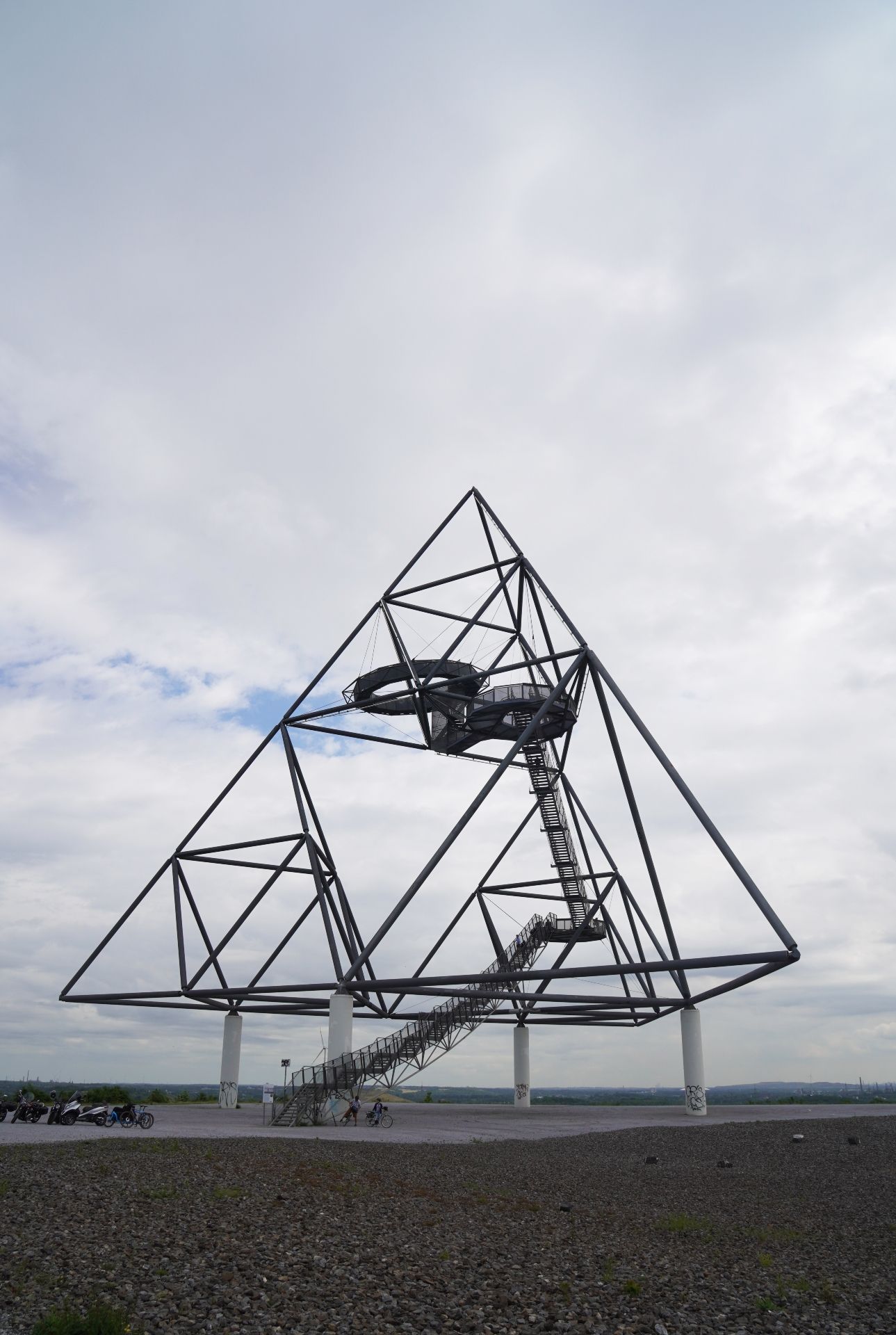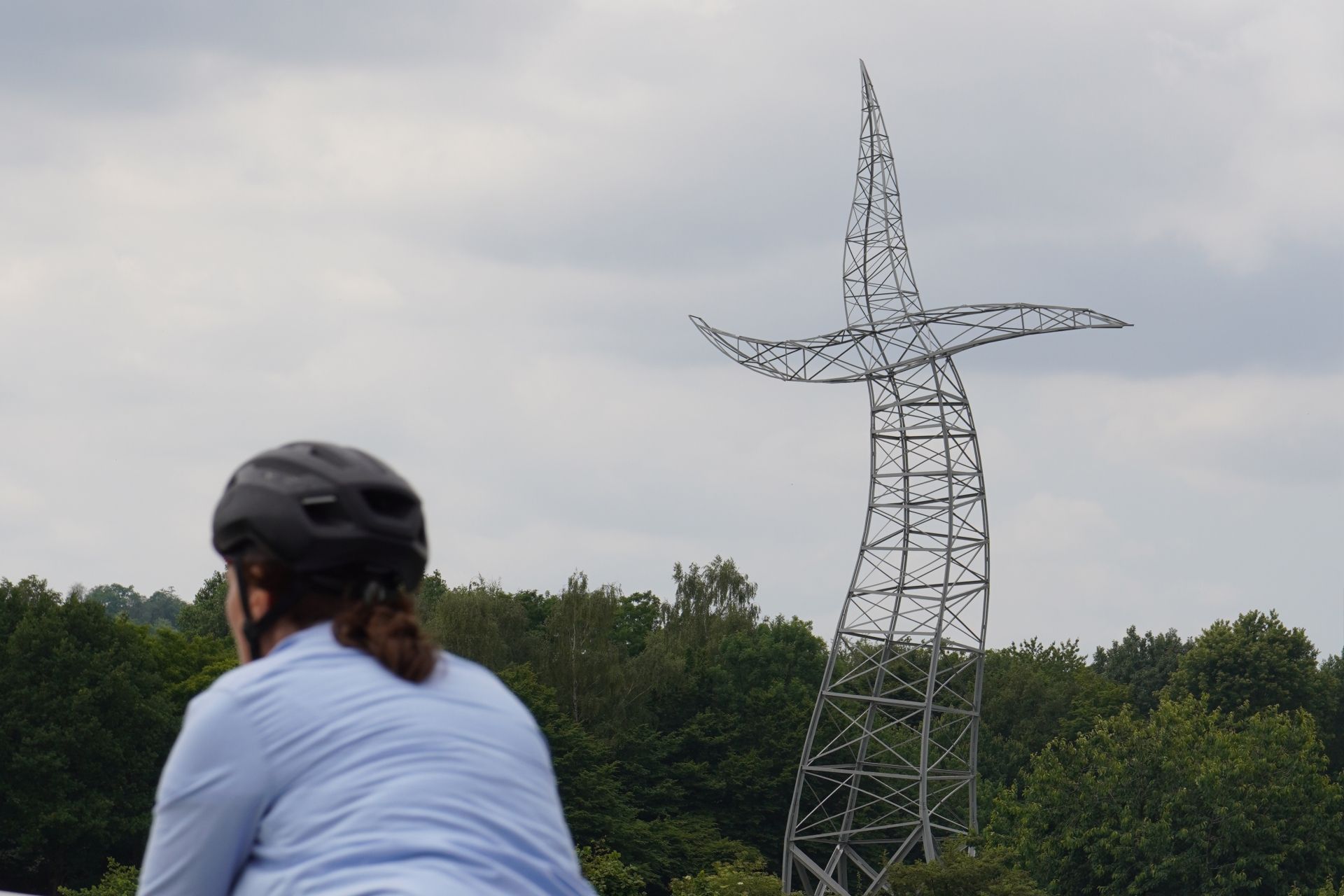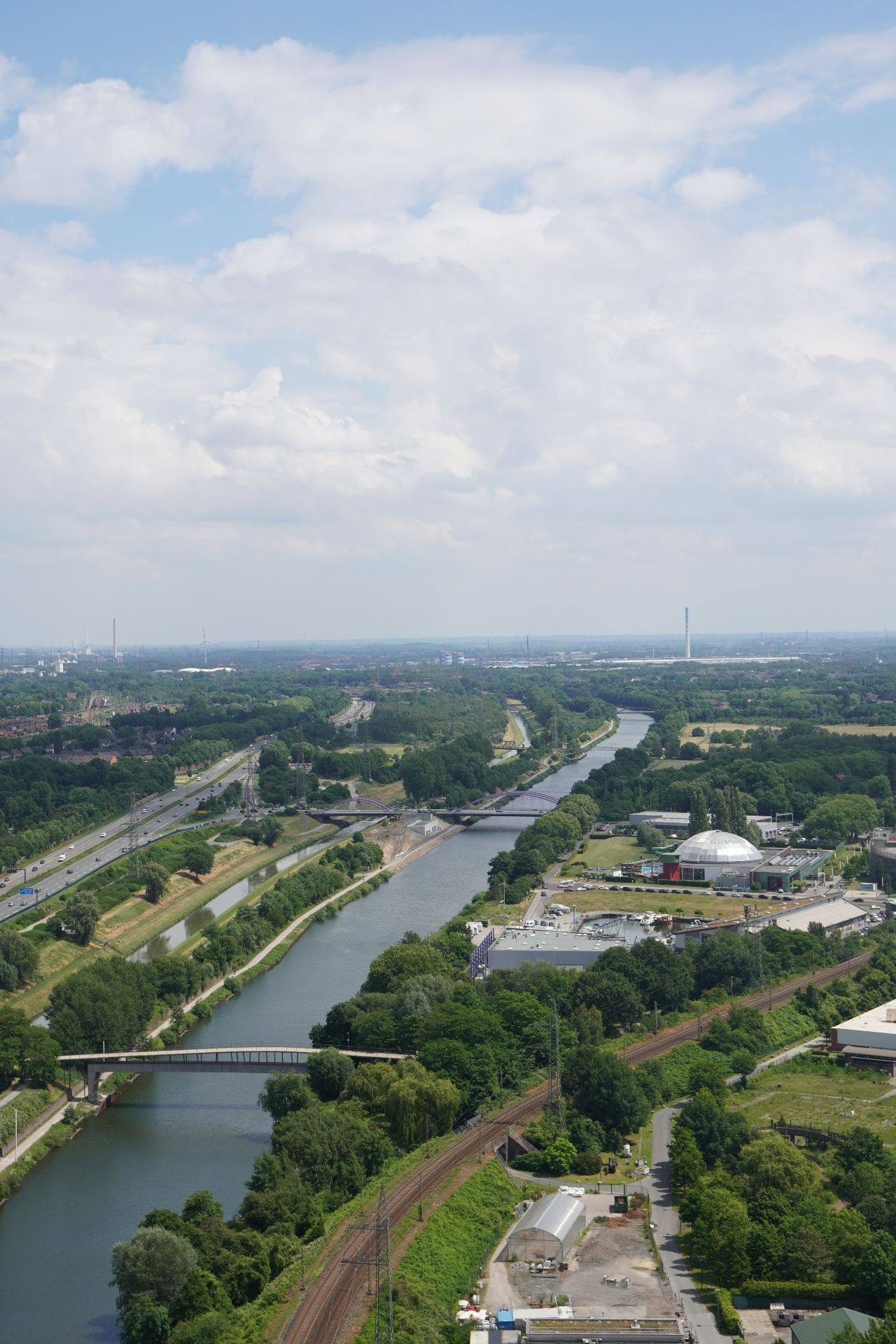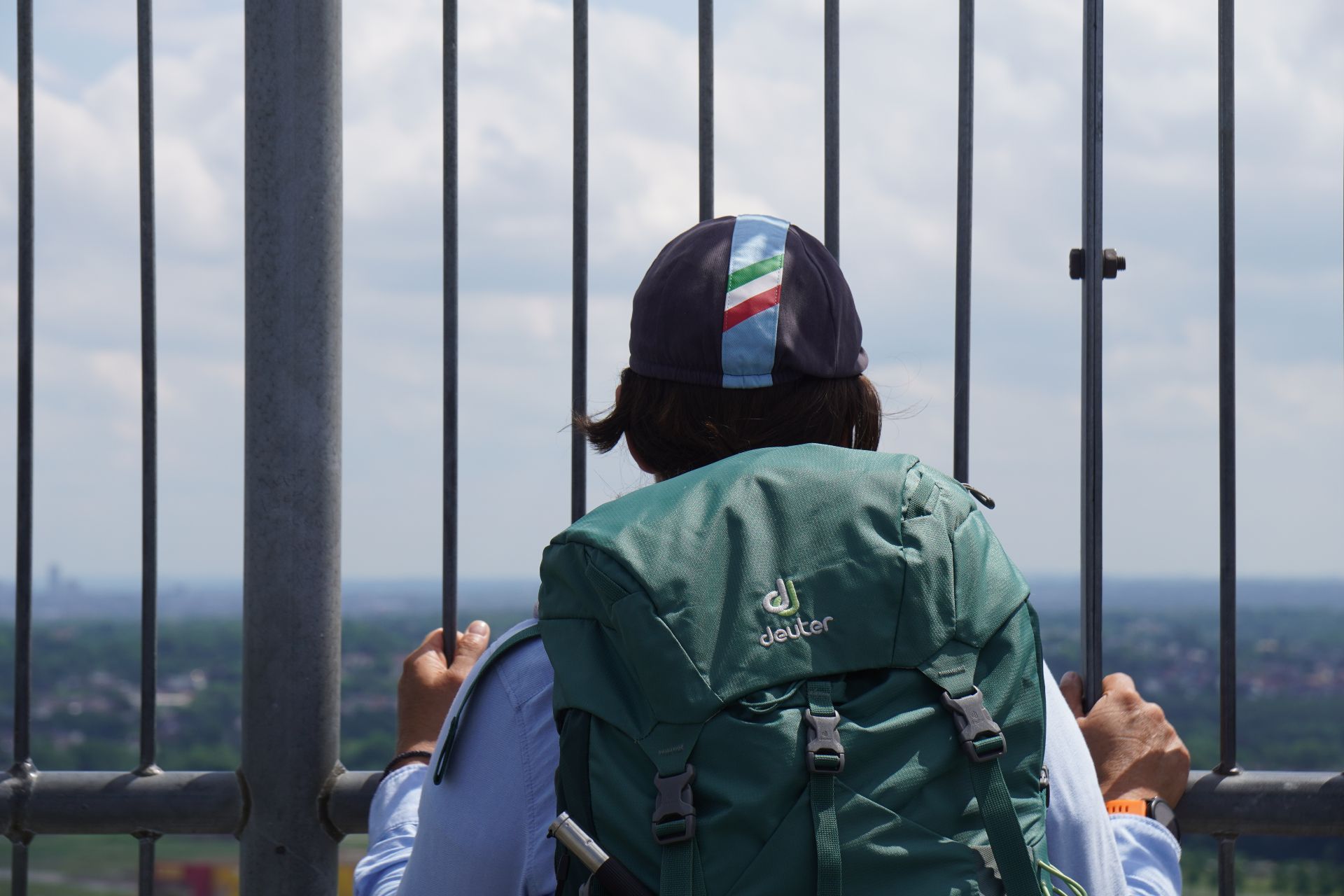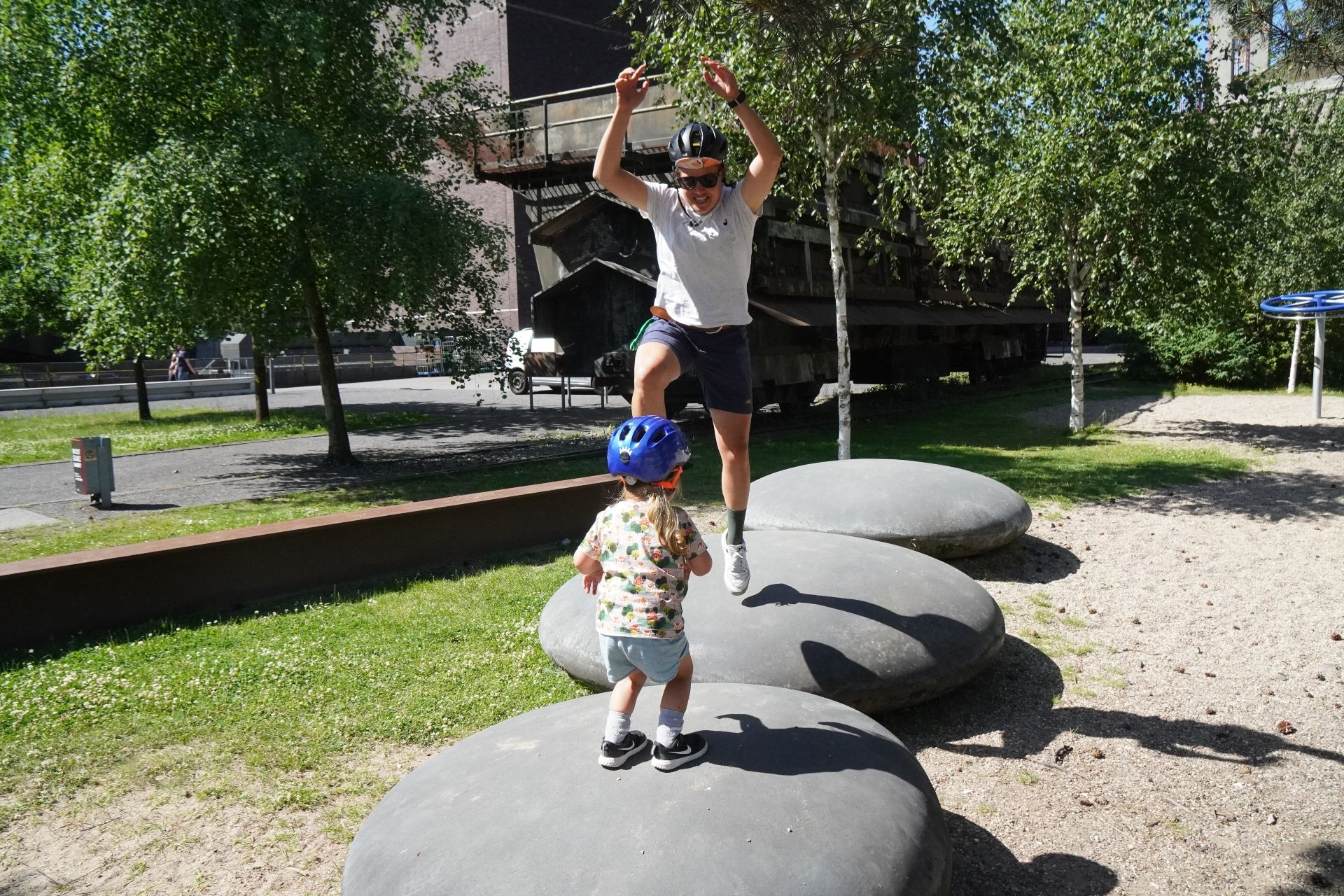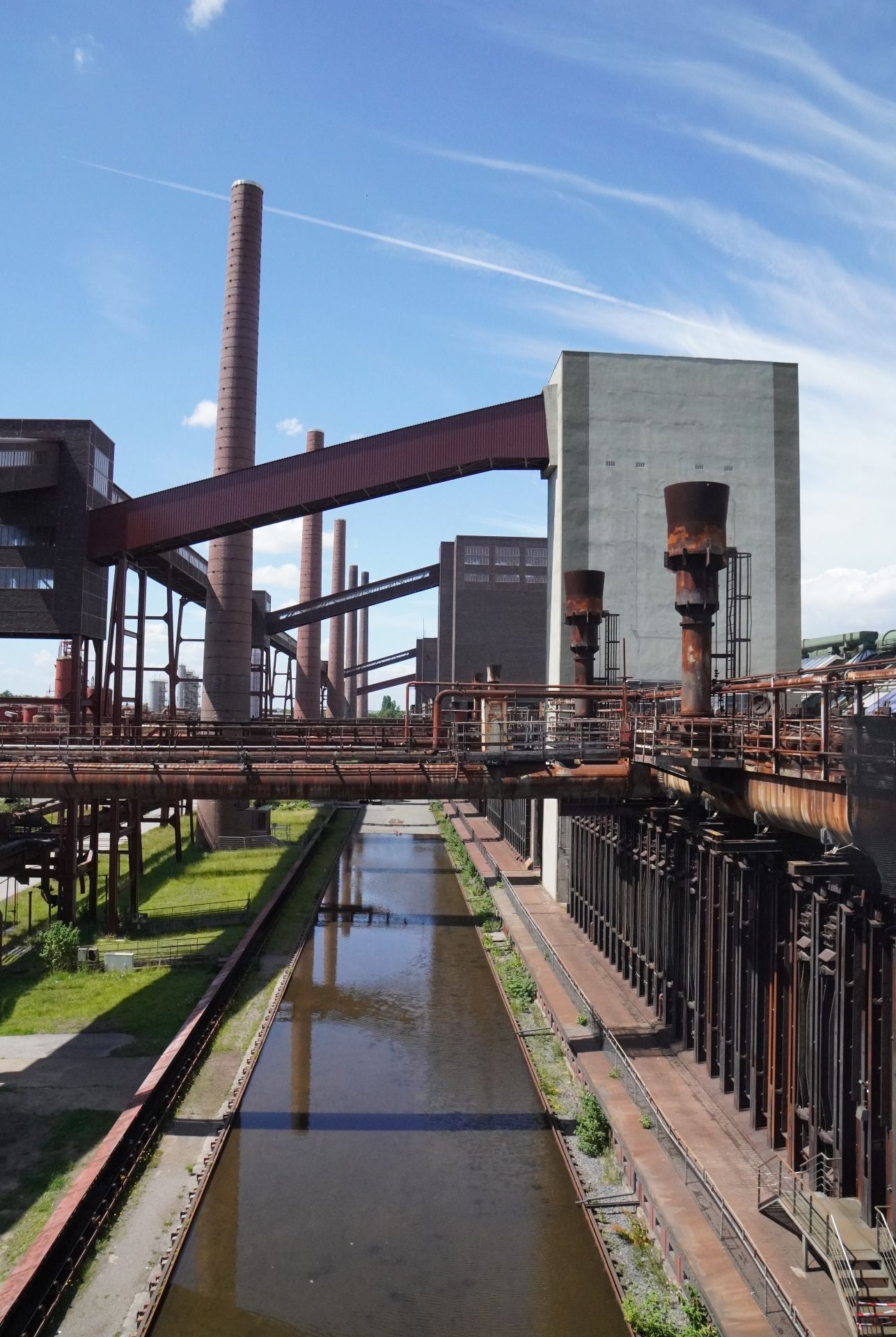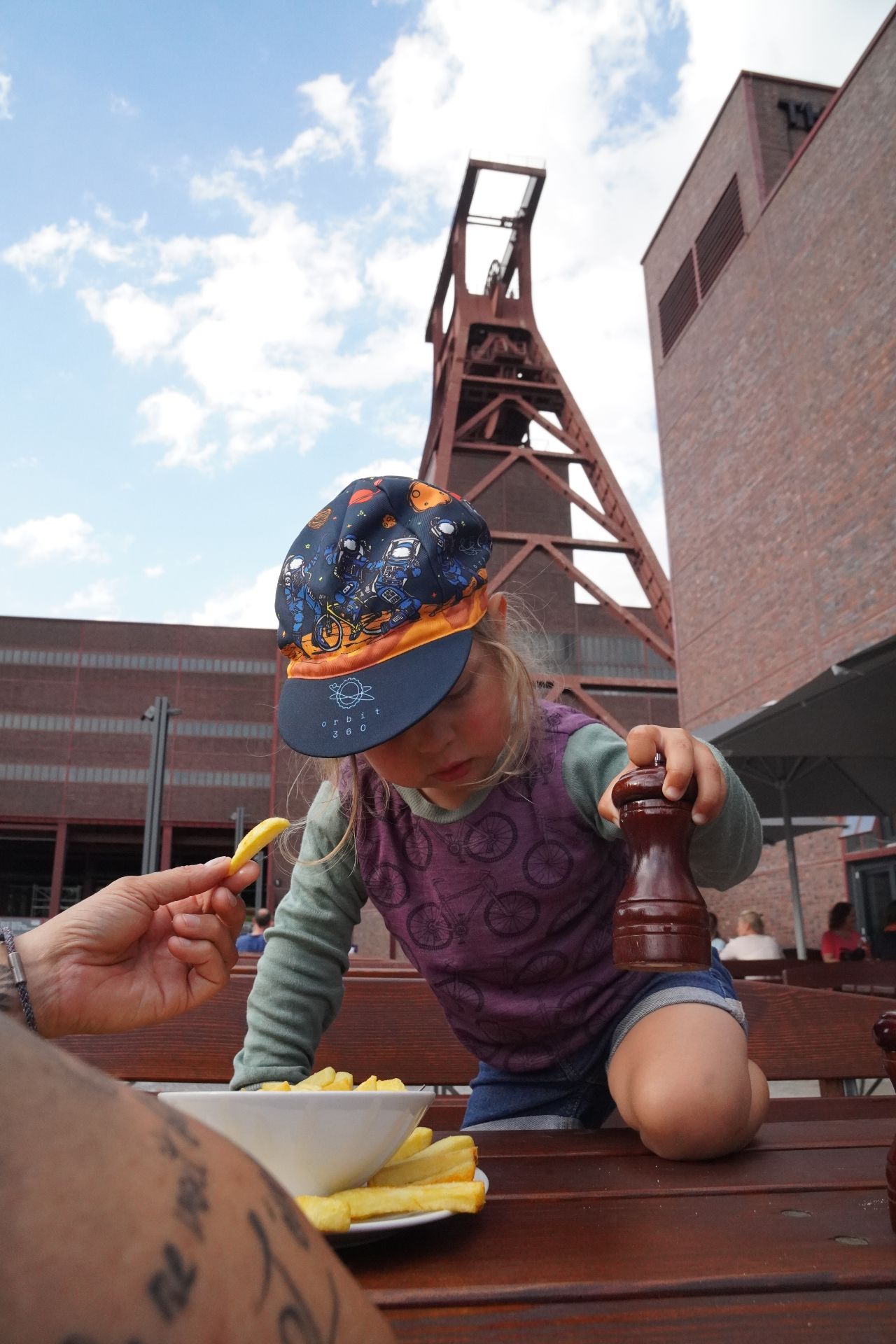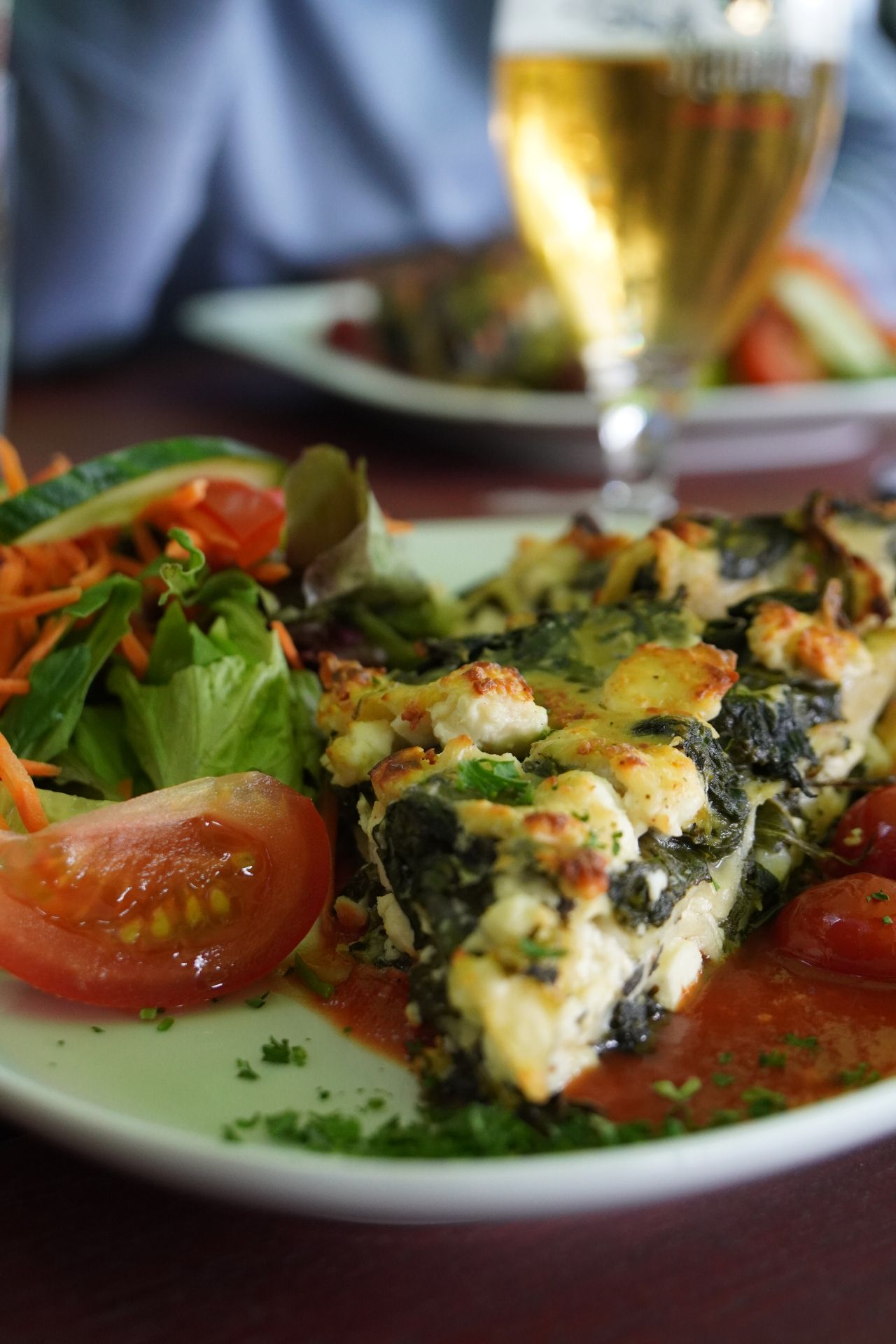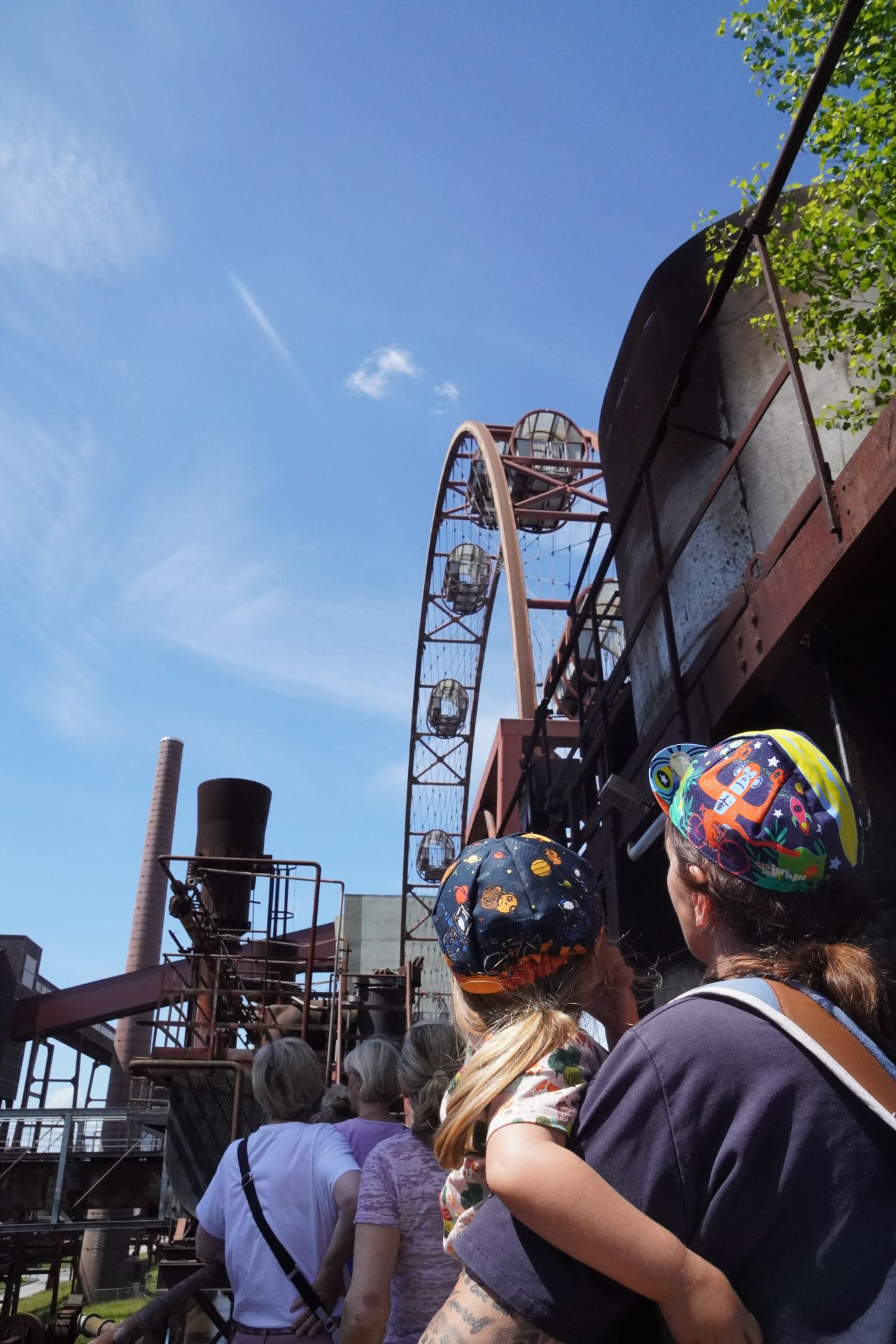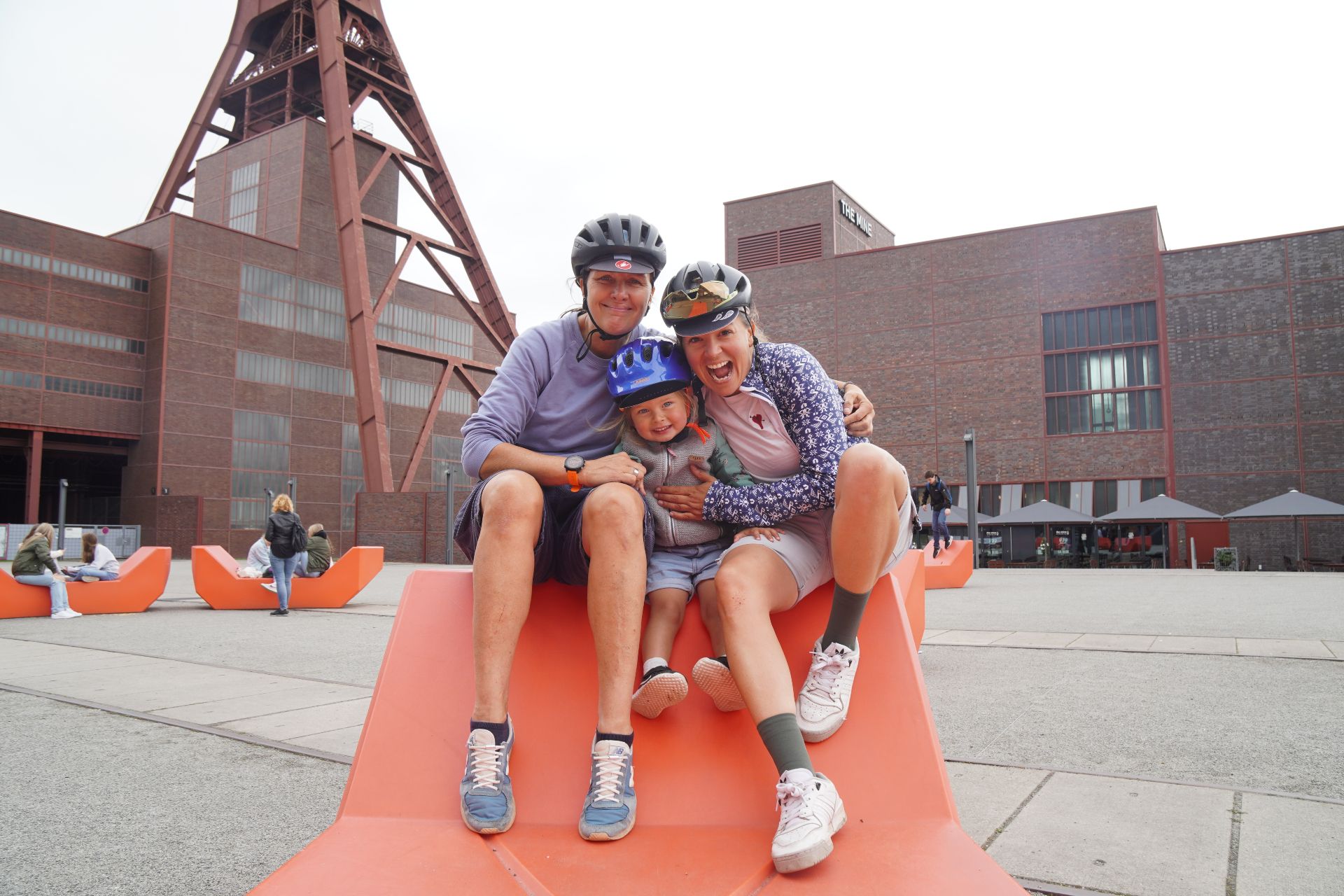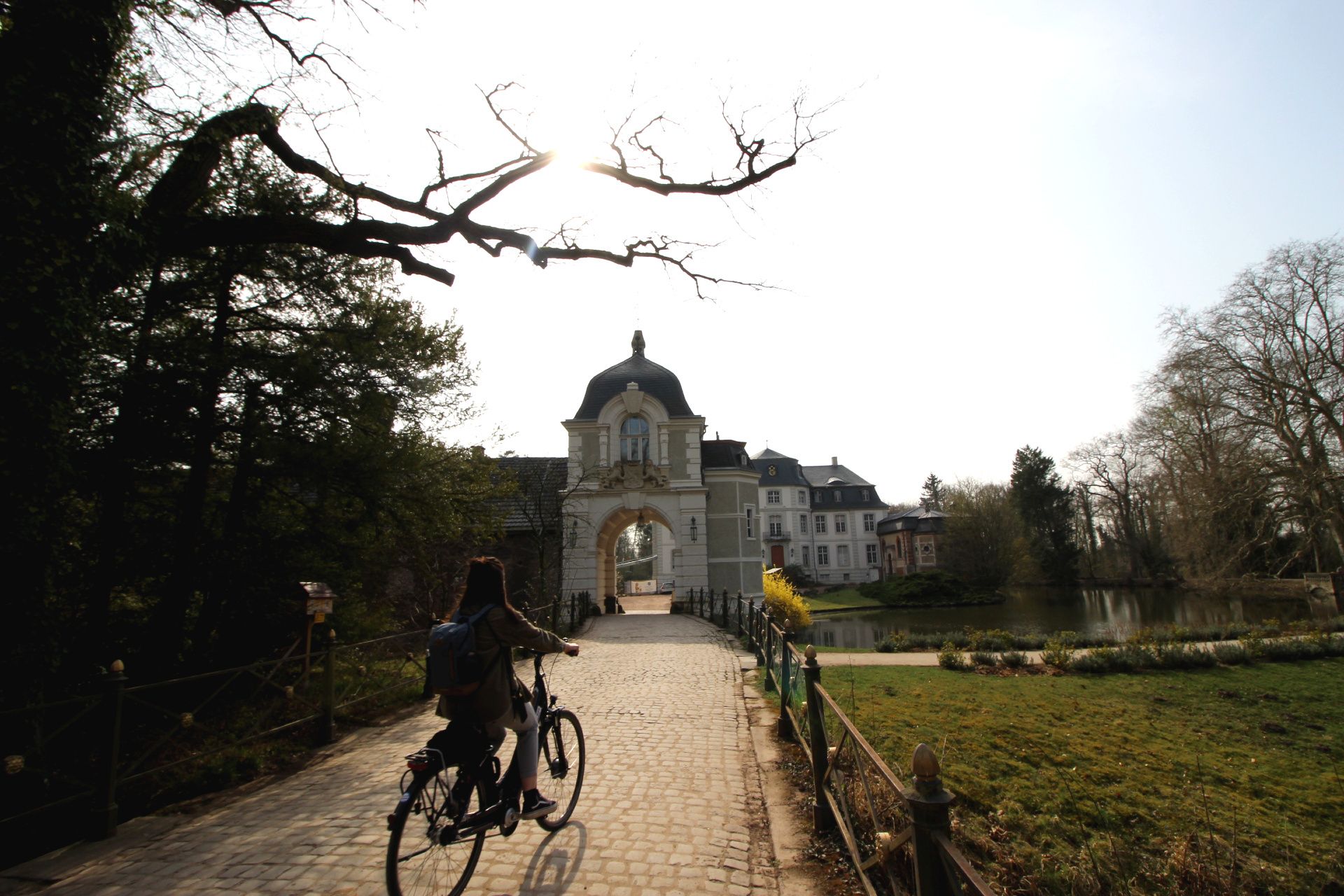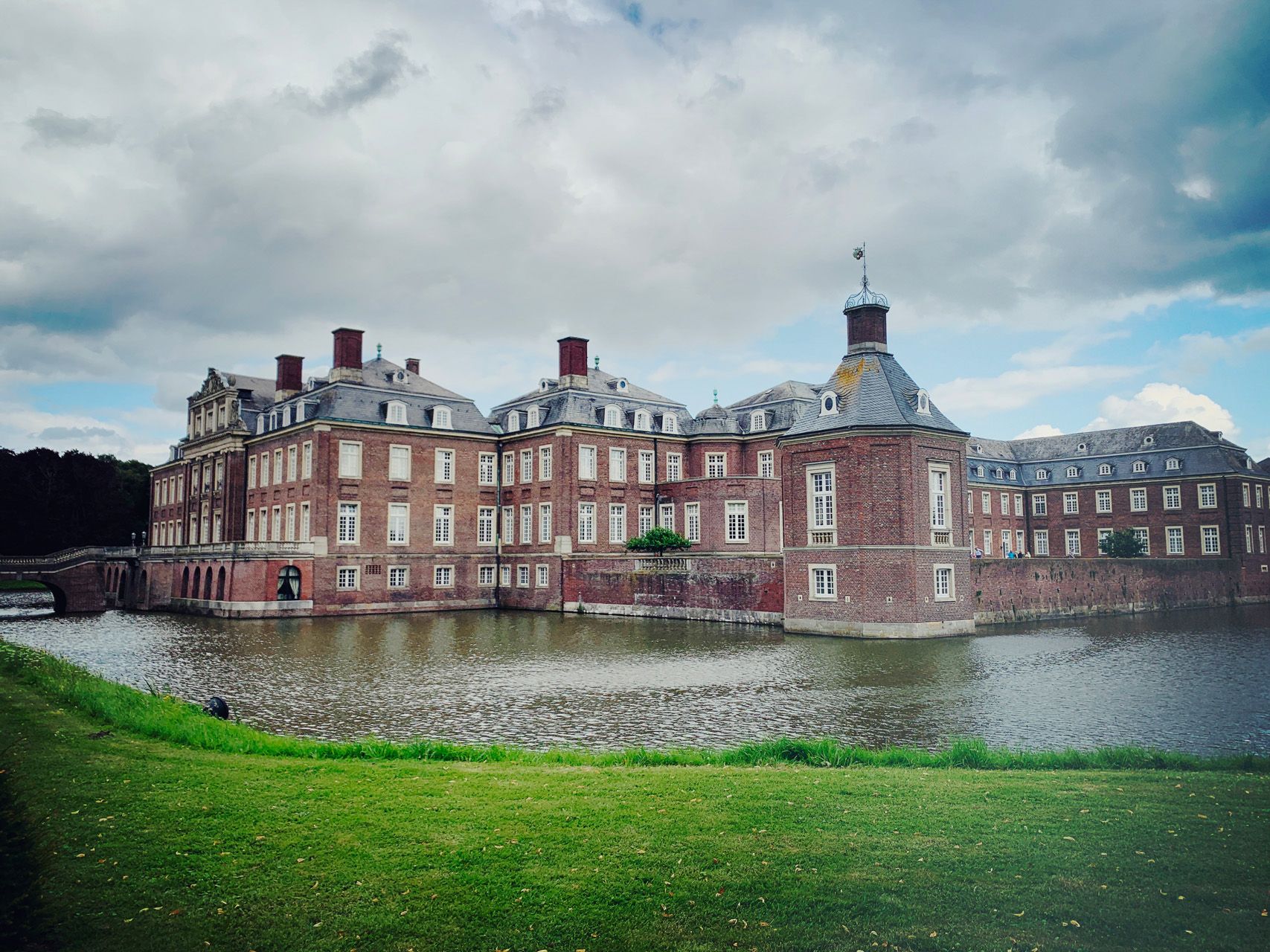I plucked our rucksacks from the corner under the wardrobe, two large ones and one small one. "Mum, are we going on a trip?" our daughter asked me excitedly, as she always does when a rucksack is getting ready to be filled. I had to smile before she had finished the sentence: "Bente, tomorrow we're going on holiday."
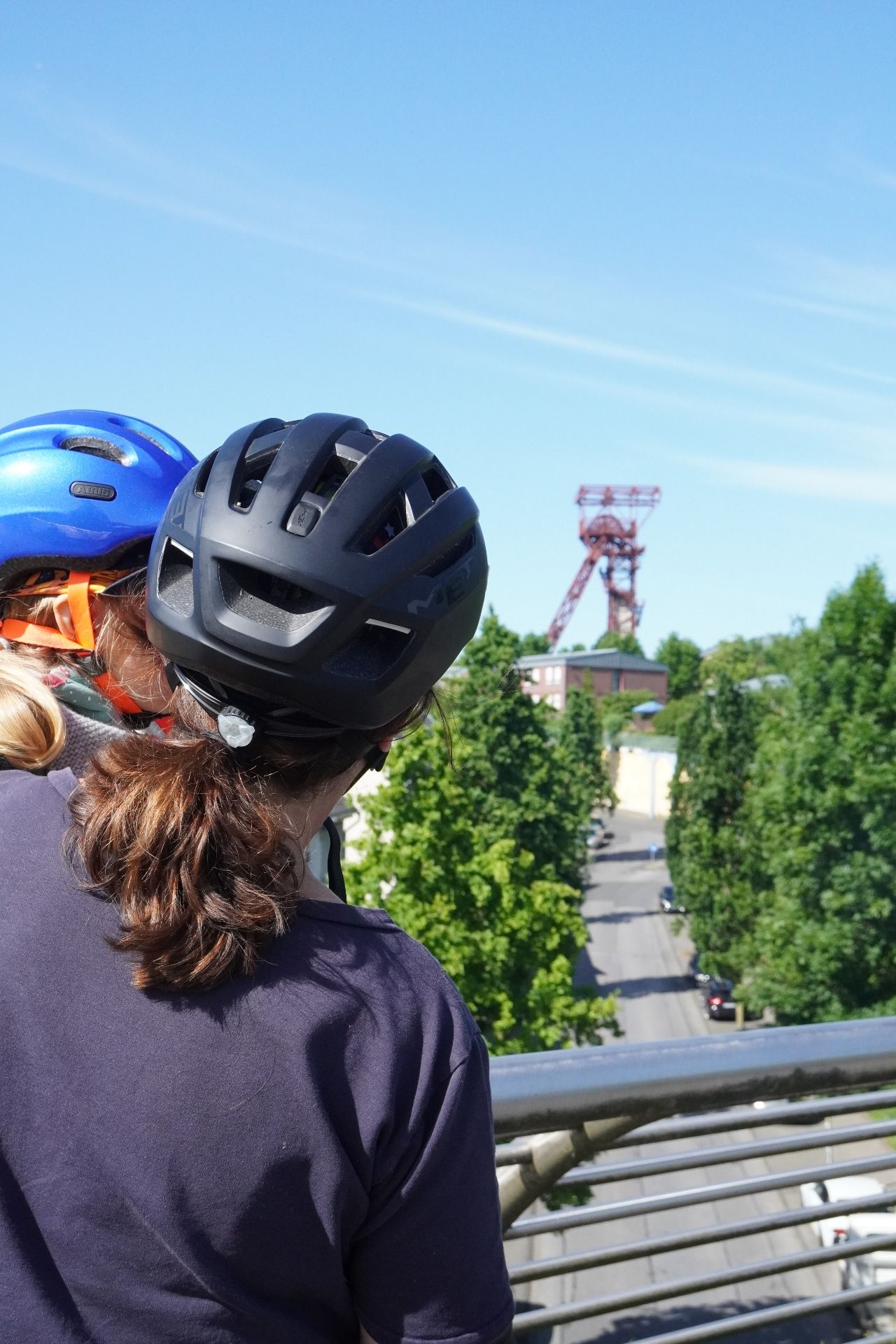

A pot full of stories
Experience the Ruhr region by bike with the family
Short holiday, small luggage, maximum enjoyment
Escape the daily grind and get away for a few days. Yes, please! But a holiday with rucksacks and no bulky suitcases? I had never thought of this in connection with a family holiday including a small child before, but I really liked it. Because to be honest: I'm really happy for all those people for whom relaxation begins with the anticipation of packing. Yes, I could also talk about a form of envy here, because I'm the kind of suitcase packer who can never commit to anything, wants to take everything with me and maximises the volume of my suitcase. The addition to the family hasn't necessarily made things any better, as you might imagine. And of course, some important item is still missing in the end. Classics.
However, the combination of the size of the rucksack, the length of the trip and the distance to the destination ultimately saved me from having to make numerous decisions about the packing list, wiped the panes of my inner stress tolerance window clean and gave me a large portion of anticipation as I looked forward to three really exciting days.
When Bente hears the word holiday at the age of 3, she looks forward to mountains or thinks of the sea. I also have a longer journey in our fully loaded tin bowl in the back of my mind, which usually ensures that we arrive at our holiday destination completely overripe and slightly fermented. Only to let the relaxation we have finally gained fizzle out again on the journey home. But this time everything was to be different, because with a number of pedal revolutions that fitted into just 40 minutes, we arrived at our holiday destination on our favourite vehicles:
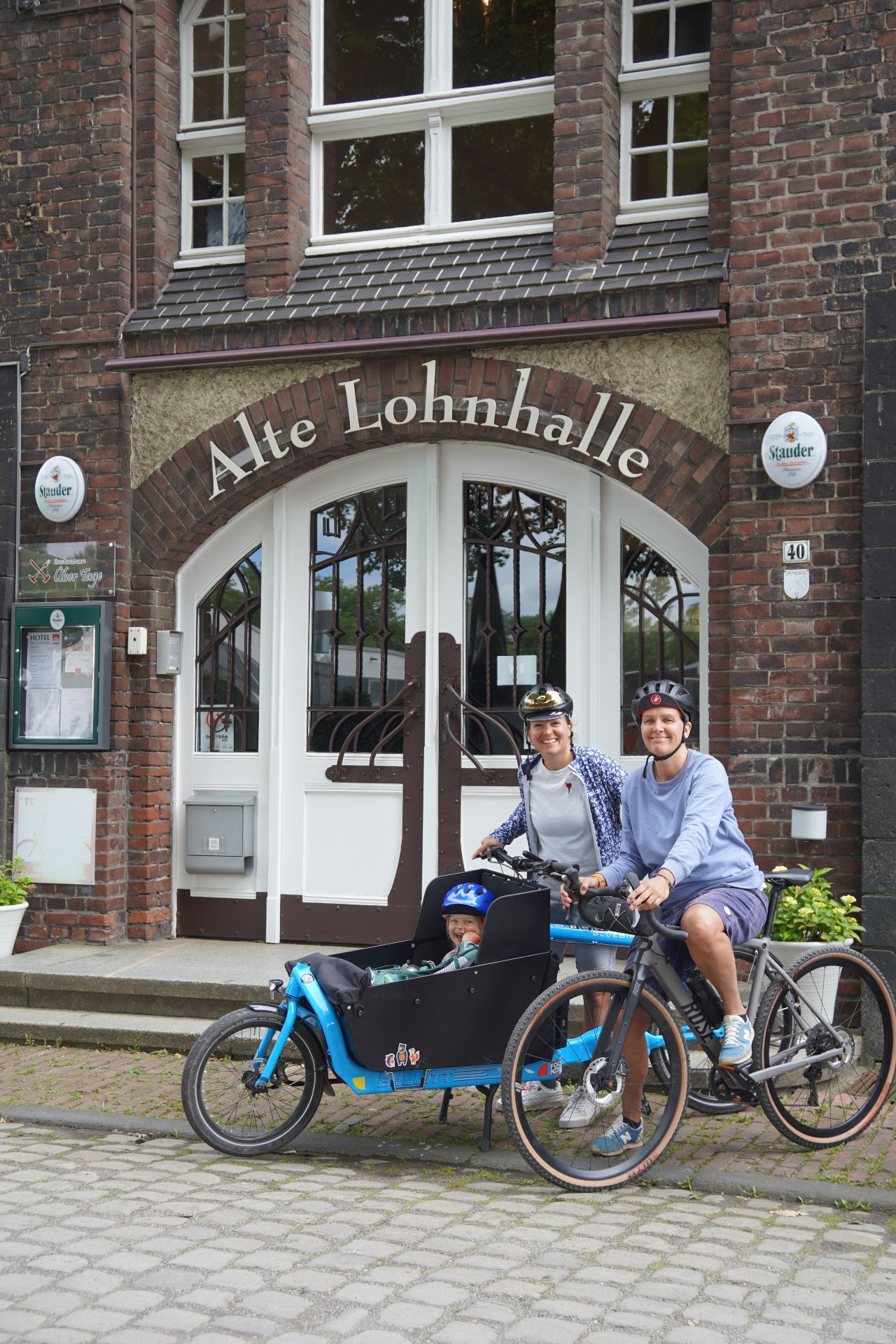
Good luck at Bonifacius colliery! Hello "Alte Lohnhalle"
Where the miners used to collect their hard-earned and well-earned pay packets, the coal dust has of course long since evaporated. What has remained is the honest charm of industrial culture that makes the Ruhr region so special and unique. Today, hotel guests are rewarded with warm service, local delicacies from the "district kitchen" and - after exciting expeditions through the Ruhr - a good night's sleep. As an official Bett&Bike hotel, bicycles of all shapes and sizes can also be safely parked for the night. (The "Alte Lohnhalle" hotel is now permanently closed).
At home on holiday?
Three days holiday in the Ruhrpott, in other words, at home. Not even an hour away from your own front door. No suitcases, no long journey. No snow-covered peaks or cool, salty water. Is that possible? "Isn't the term 'holiday' perhaps a bit too big?" I asked myself casually. Eagerly, we set off, by bike of course, in search of an answer to the question of what exactly constitutes a holiday. Kilometre by kilometre, we explored two planned routes from the Ruhr Tourismus GmbH(www.radrevier.ruhr) offer and were regularly impressed by the industrial culture programme, which repeatedly invited us to marvel, linger and experience. But first things first!
Coal mine charm to "feel at home"
It was Friday morning when we arrived at the hotel. While my wife Sabine and I immersed ourselves in the beauty of historical architecture, Bente and her echo enjoyed themselves in the spacious entrance hall of the "Alte Lohnhalle", which housed the lobby, restaurant and reception. Cheerful children's squeals resounded when we opened our room door, where the first thing that greeted us was a bright red dinosaur-shaped stool. We took advantage of Bente's little trip back to the Stone Age and found a fantastic mix of tradition, modernity and comfort in the lavish rest of our room with a view of the colliery tower.
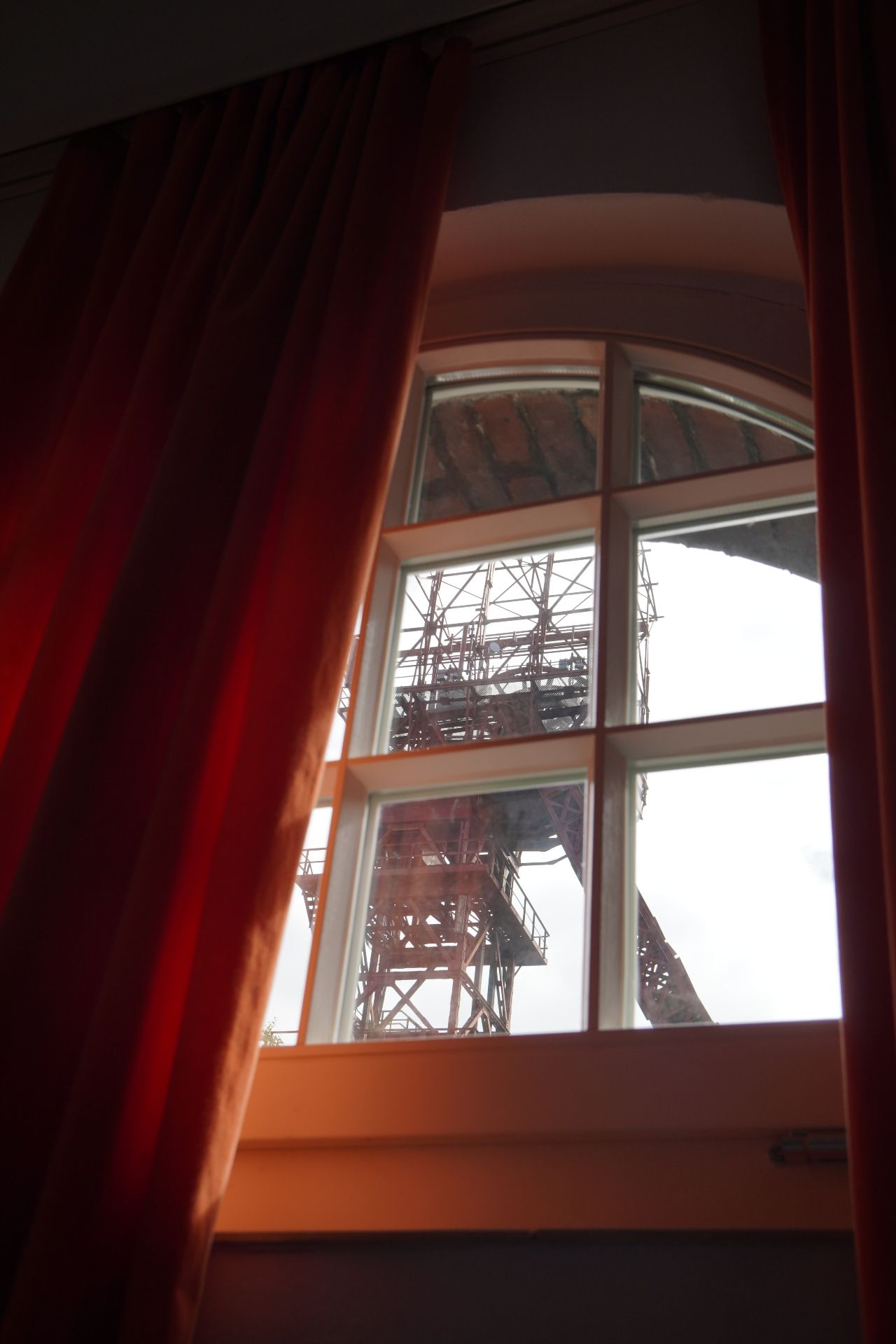
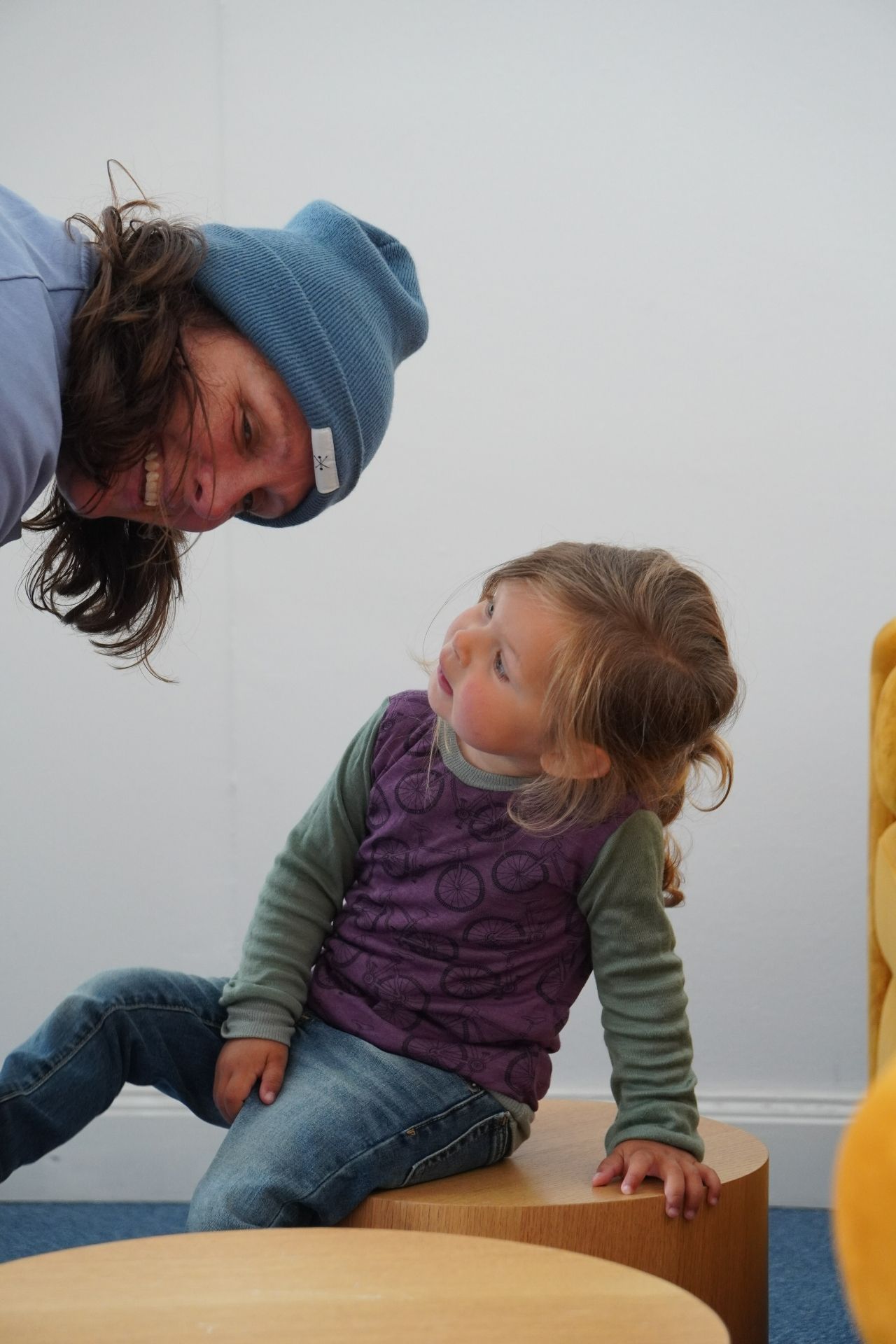
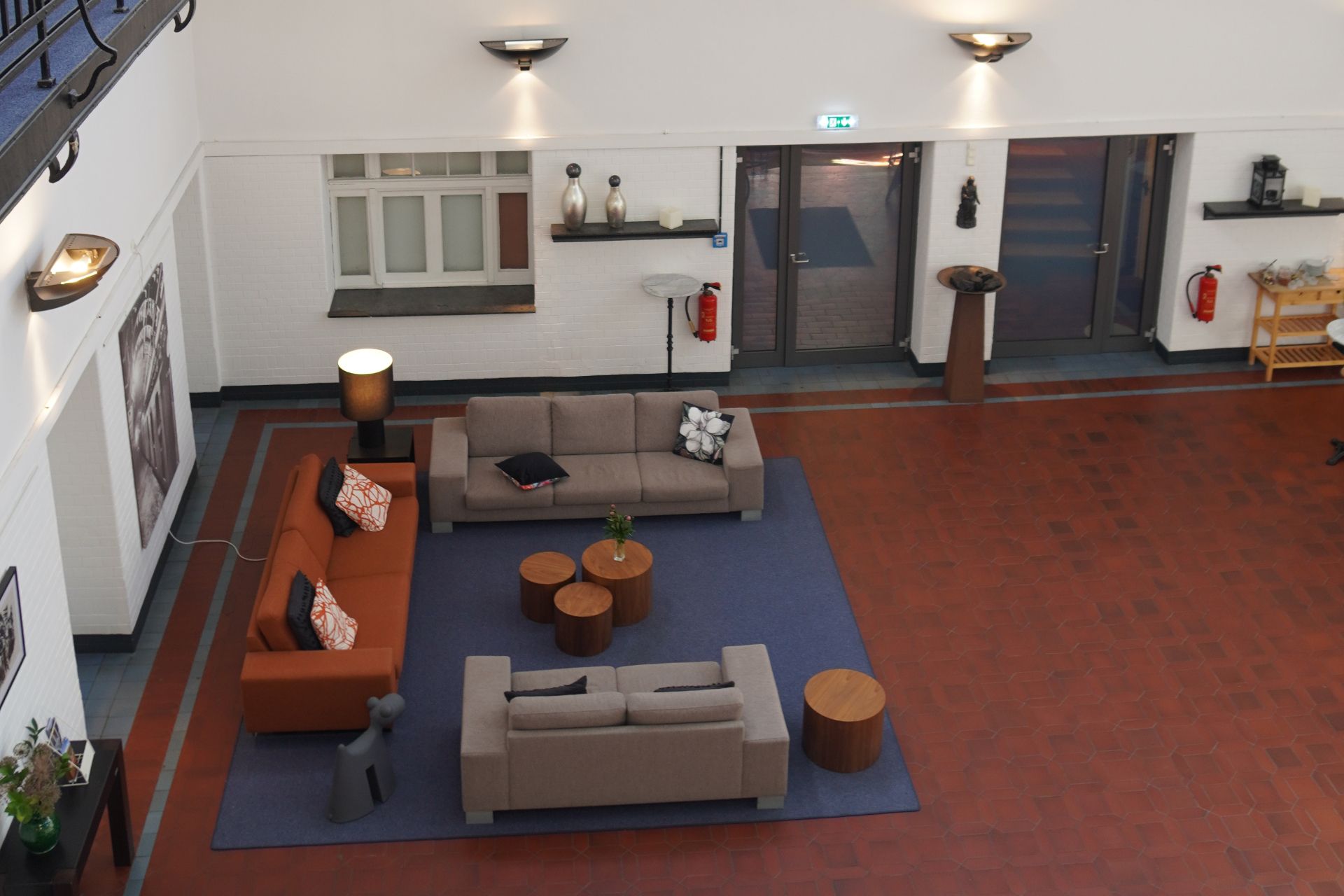
One tour, two bikes and three times the excitement
Shortly before the sun had reached its highest point, our feet were already back on the pedals of our bikes. Incidentally, we were travelling on a cargo bike this weekend. Our daughter had made herself at home in its transport box - of course I don't like to call it a "load". There was also room for toys, a change of clothes, food and the box with the children's music. The second bike was a gravel bike - the sporty touring bike for maximum surface flexibility.
Our first route was called the "trial section". My subconscious was immediately triggered and sent images of juicy slices of cake to my mind's eye. So it would be delicious too - at least in my imagination. But I'm naturally optimistic when it comes to this topic: "Where there's a delicious bike ride, there's also a delicious break". At just under 30 kilometres, the route was the perfect length for the day of arrival, leaving plenty of time for activities along the route. At this point, however, we didn't realise that the range of small and large sights on offer would be as extensive as the selection of a mixed bag of Klümpkes from the local snack bar.
The Zollverein colliery, a UNESCO World Heritage Site, is probably the queen of culture in the colliery landscape and the starting point for the tours. In awe of its size and history, we left it at an extensive round of the giant orange escalator for Bente at the old coal washing plant and soon set off on our round trip around Gelsenkirchen.
Off the site, into the network of old railway lines and up onto the first spoil tip
After less than three kilometres, we were rewarded with the first 360° panoramic view in "full view". "Rheinelbe" is the name of the hill from the spoil of days gone by. Sabine was amazed when, after the relatively short ascent to the top of the spoil tip, she found herself next to the stone artwork known as the "Sky Ladder". She gazed into the clear and sunny distance, with a view that exceeded her expectations. A perfect introduction to the Monte Schlakko parade of the Ruhr region. My index finger travelled across the horizon on an outstretched arm and paused at one landmark or another - because as a Ruhr Valley brat, I'm a few steps ahead of my wife, who comes from Hesse. And although I grew up here and am very happy to have stayed, I realised once again that there were always new discoveries for me in the coal region.
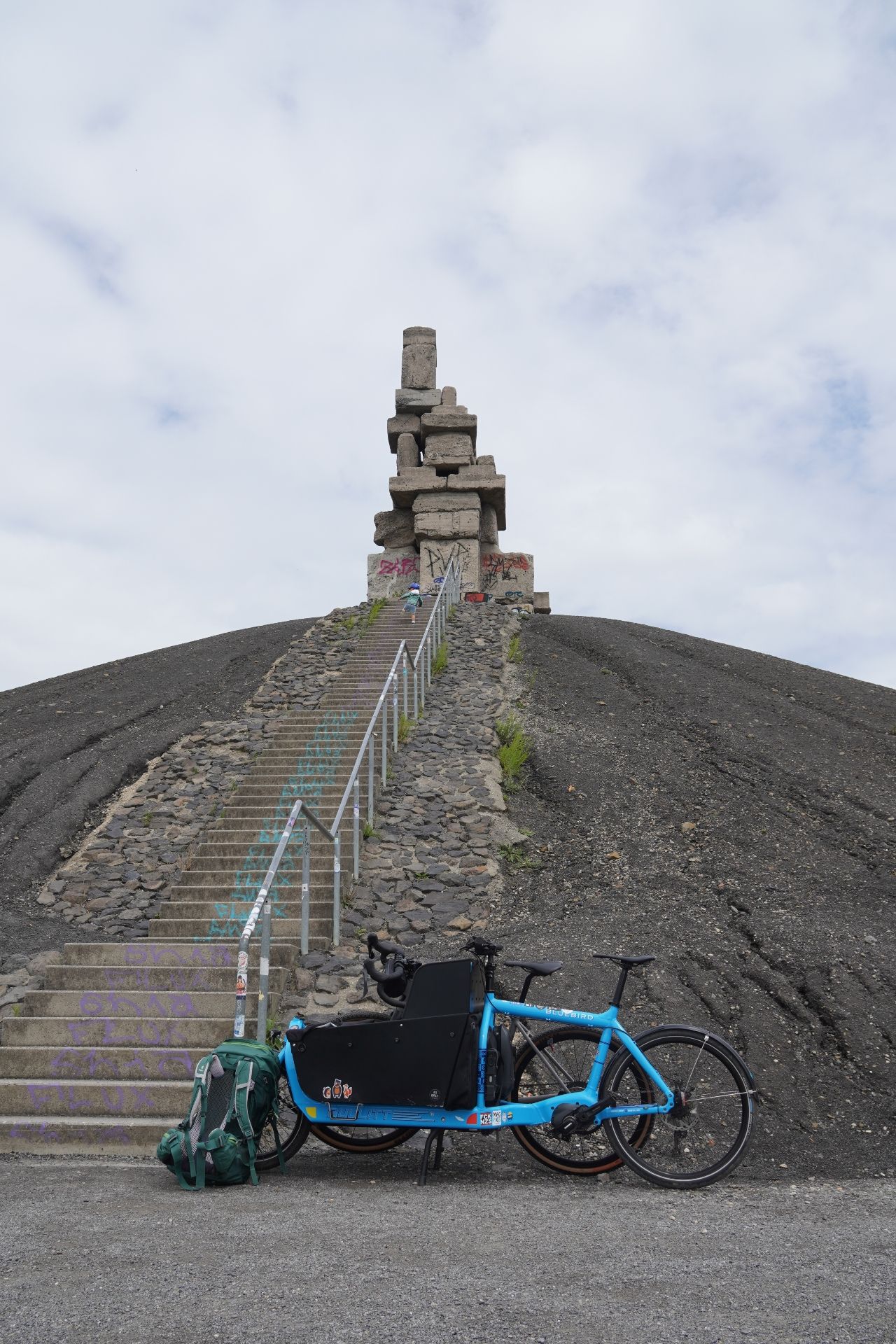
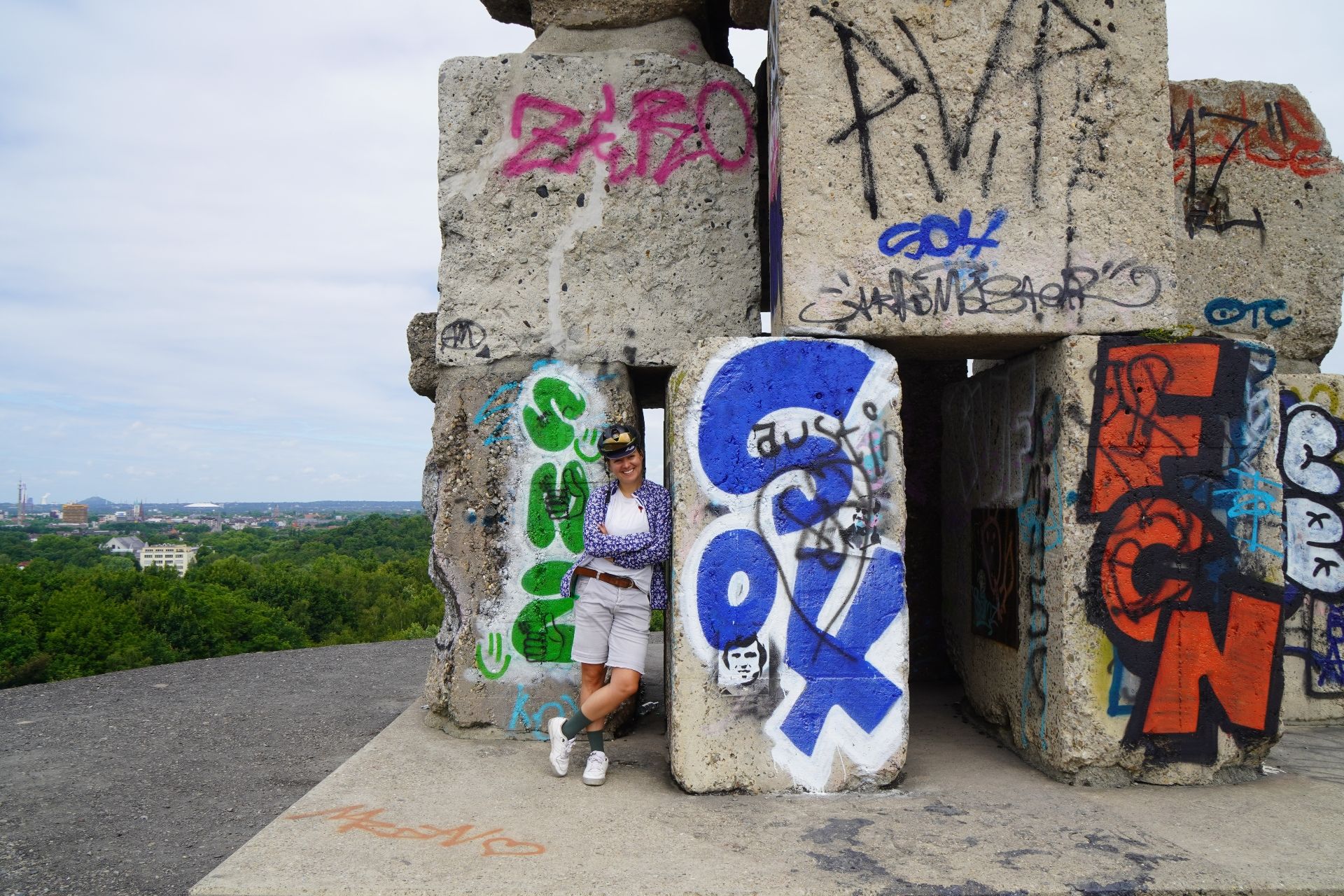
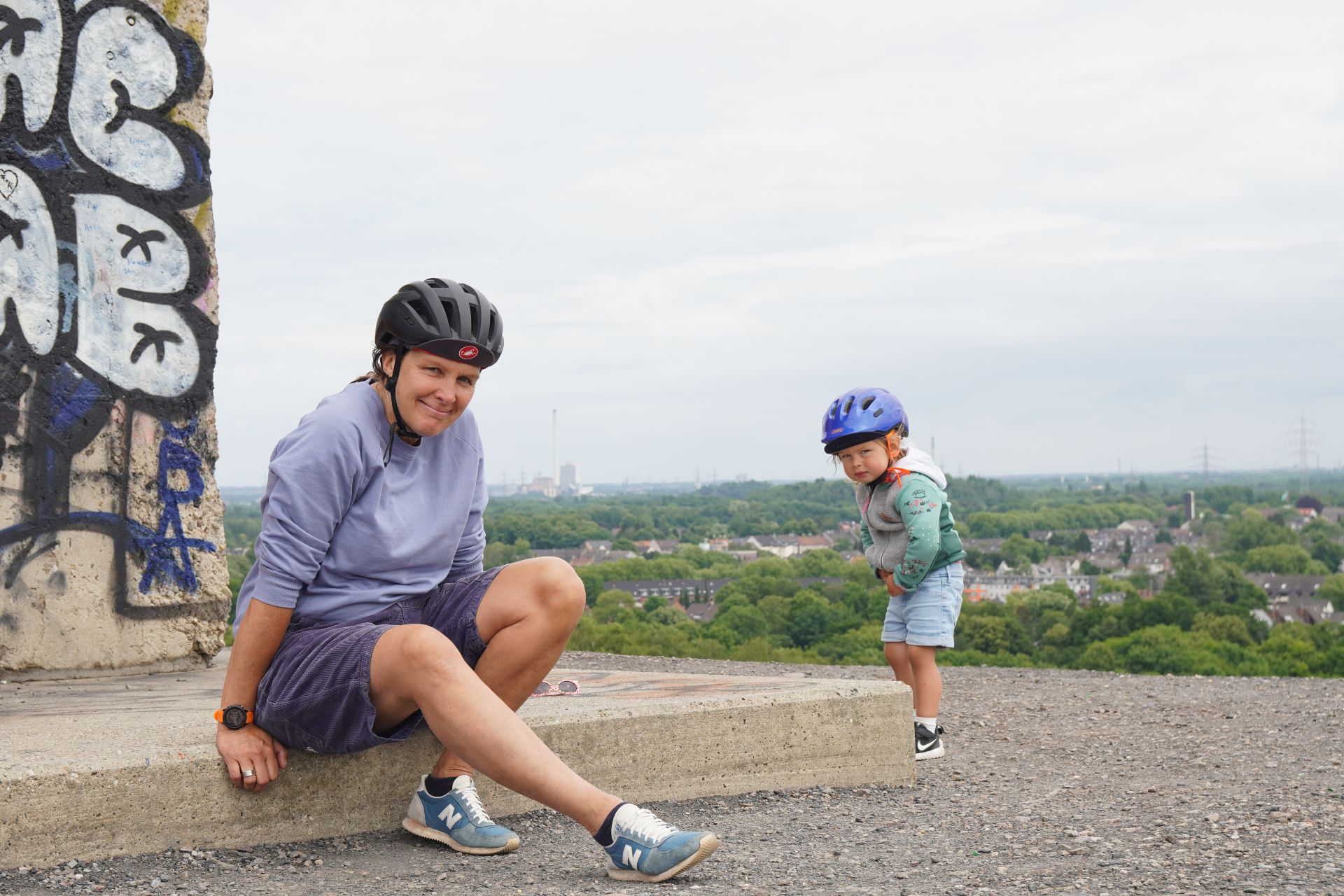
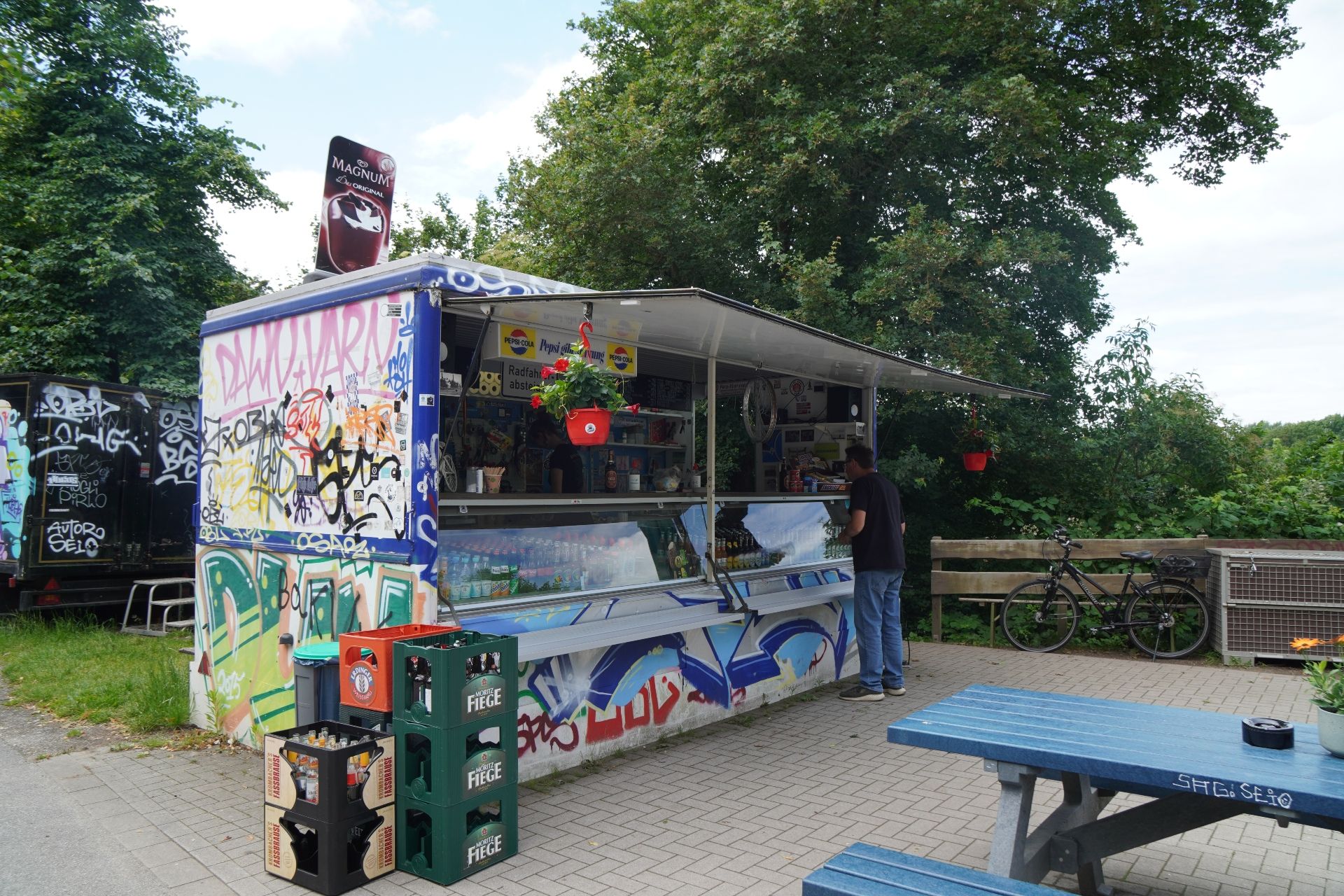
In the meantime, Bente was mainly interested in the architectural elements in the immediate vicinity. Whether she was standing on a snow-covered mountain or a hill covered in slag was of course completely unimportant to her. She followed her urge to move and quickly verbalised her growing hunger. A small picnic with a great view then delighted us all equally. 360° satisfaction.
With the momentum of the descent, we passed the sculpture forest at the foot of the slag heap and zoomed along the "Kray-Wanner railway" to its end. Here we came across the "ore railway trio", consisting of a stall, bridge and track. And as taking a break is one of our core competences, we naturally couldn't resist a lemonade at the iconic Erzbahnbude. Bente, in her childlike professionalism, chose the frozen version on a stick.
Very close to the distance
With our strength maximised, we followed the route on whisper-quiet asphalt with a gentle gradient. We crossed spectacular bridges at a comfortable speed almost effortlessly and were only stopped by wild worlds: Alaska, Asia and Africa. For the detour to other continents, we left our bikes and set off on a safari through the "ZOOM Adventure World". After a walk through the savannah and along generously designed and spacious enclosures, Bente's sparkling eyes could only be kept open by the children's playground at the entrance. We obediently followed our little boss into the sandpit. If the little one is relaxed, so are we and how wonderful it is to watch a contented child having a peaceful nap, which should follow in no time. We quietly left the zoo and put Bente to bed in her mobile bedchamber.
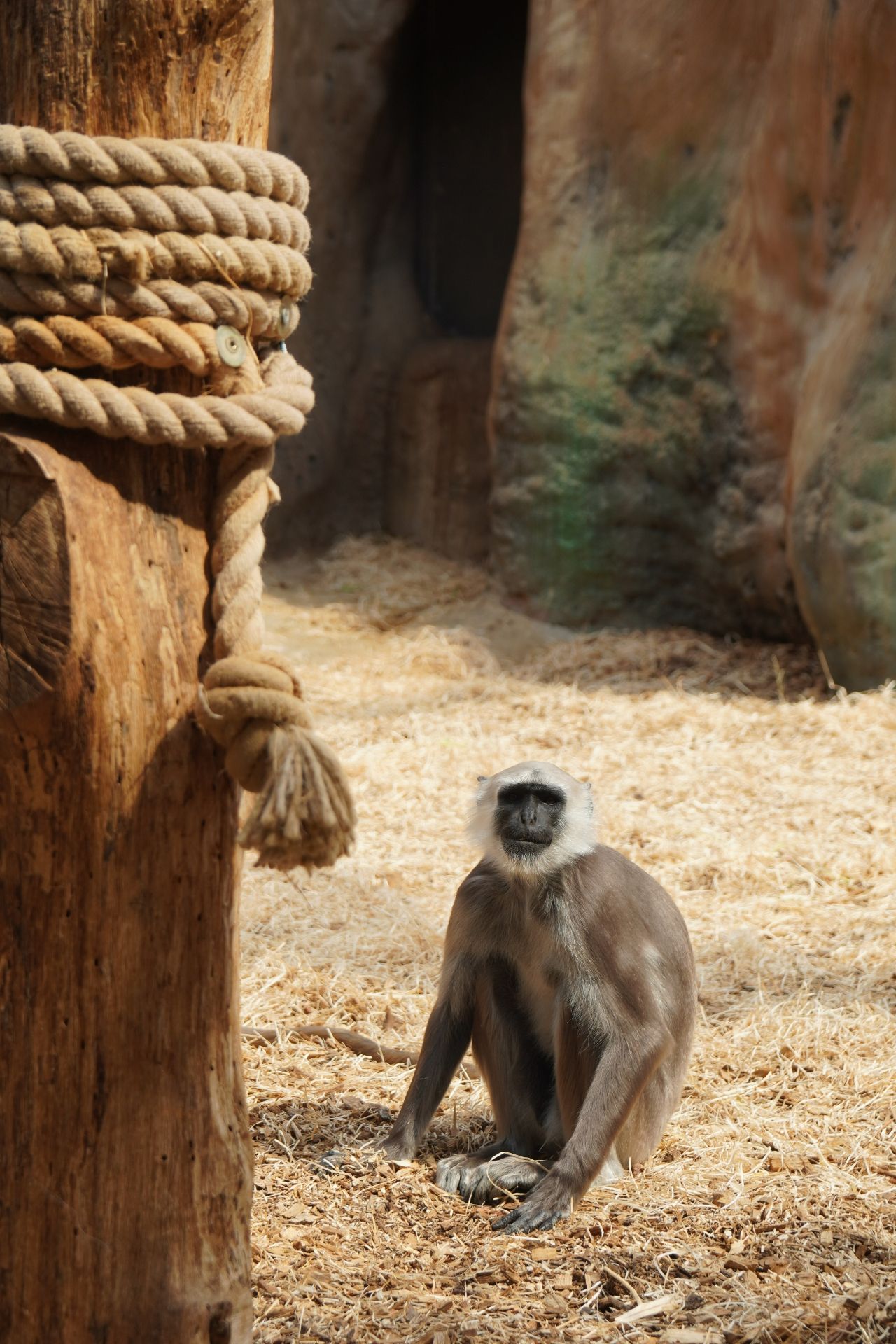

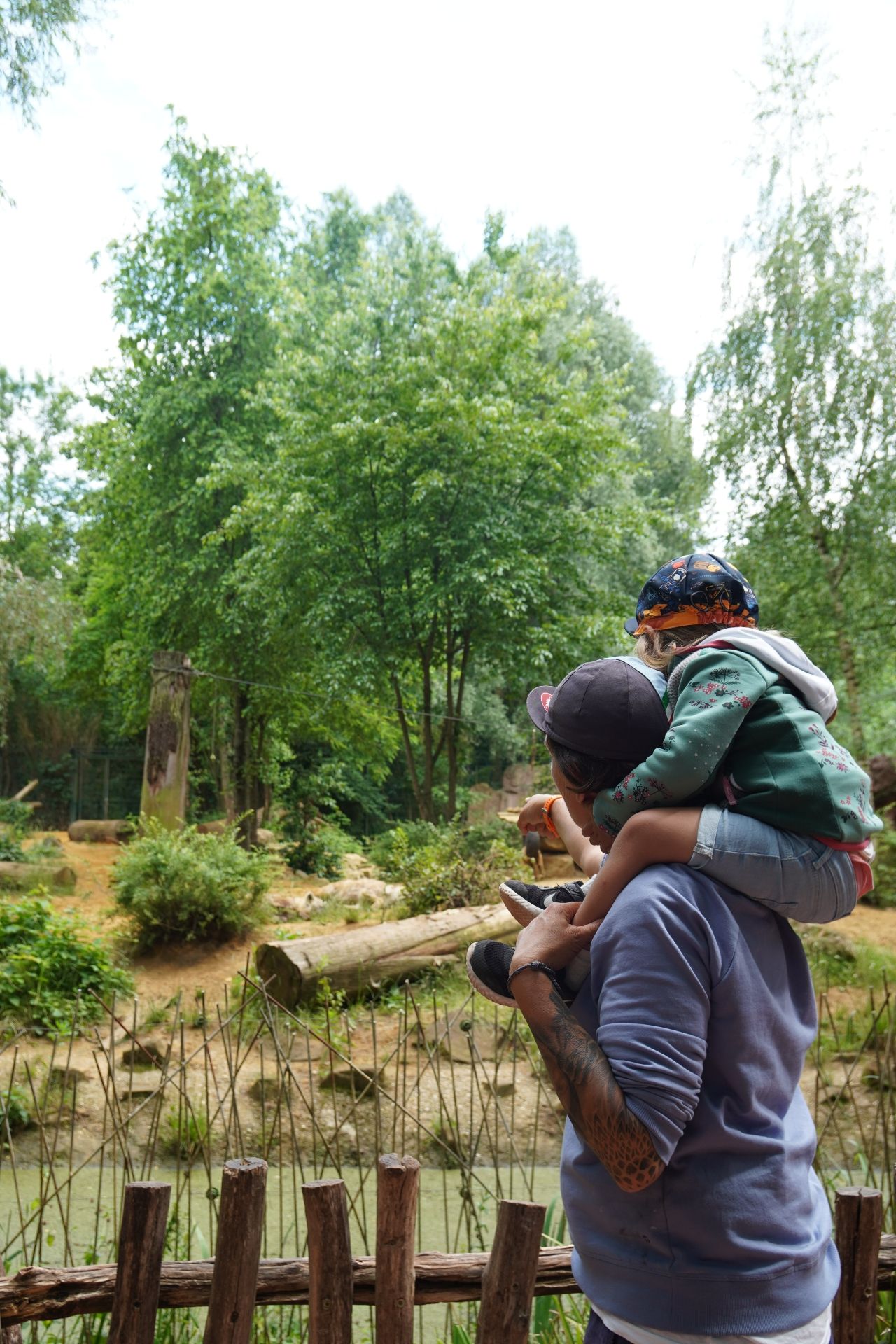
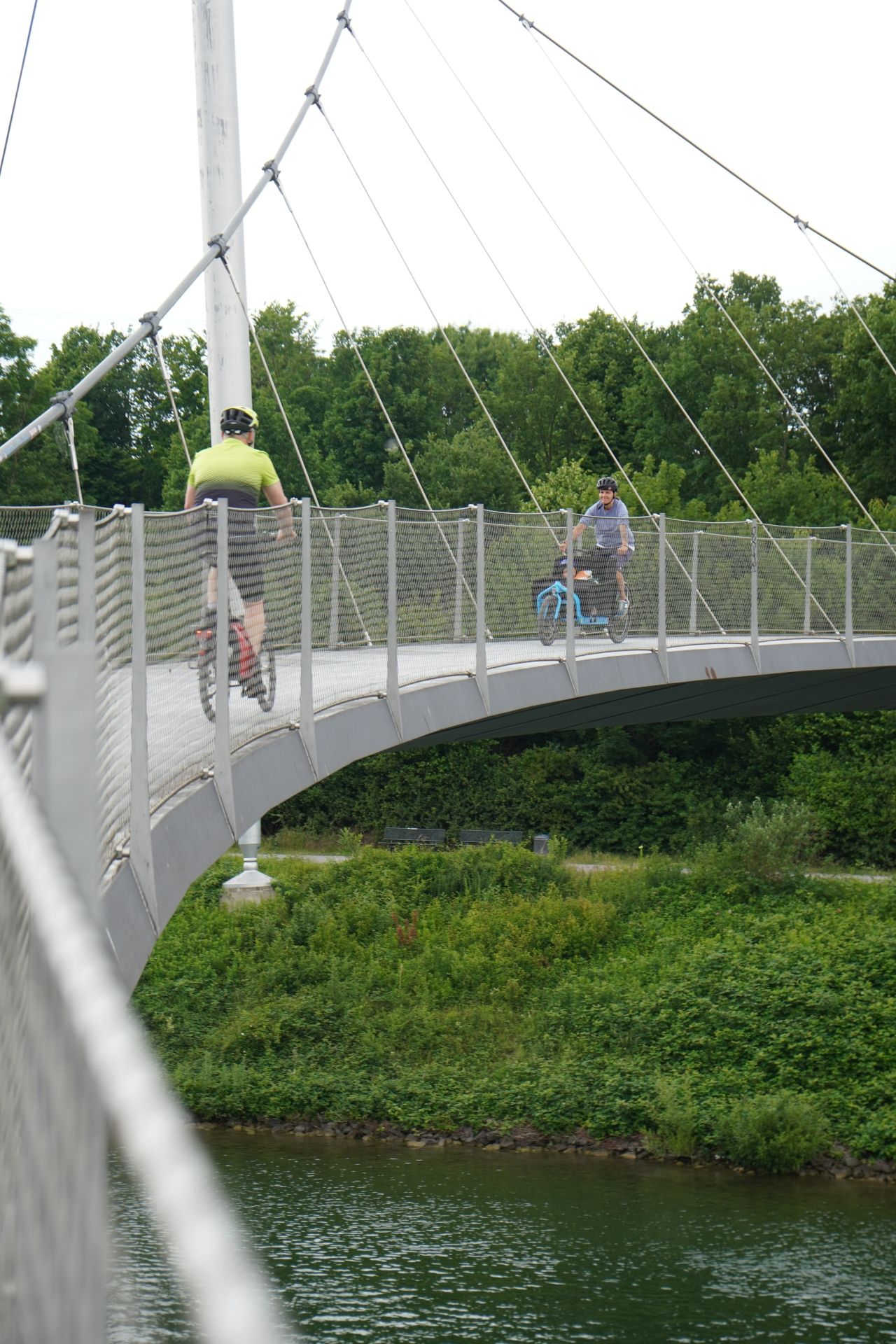
With its imposing appearance, the "Grimberger Sichel" opened the second half of our circular tour, which was to take us back along the canal bank path. The sight of the semi-circular arched bridge forced us to walk a few extra metres and took control of my tingling bike knuckles. Acceleration. What followed was a 150 metre rollercoaster party on the suspended steel structure, at the end of which I successfully recaptured my inner child. I still had a few rides to look forward to.
In the converted "Bismarck Coal Harbour", we briefly felt like strolling celebrities on the Ruhr Riviera. "The modern city quarter with yacht moorings certainly no longer resembles a factory harbour," I marvelled at the summery marina.
Before returning to the railway line for the last 5 kilometres, we passed the "Landschaftspark Nordstern" and were somewhat relieved that Bente was still dreaming of wild animals due to the late hour. Her built-in playground detector probably wouldn't have come to a standstill before nightfall, as the huge site of the former Nordstern colliery resembled an impressive adventure world for young and old as we drove past. We liked the idea of saying goodbye for a while and so we decided to come back soon to get Bente's detector needle glowing.
After eight entertaining hours, we turned back onto the Bonifacius colliery site, which housed the hotel. Happily overwhelmed by so many insights and views into the history of our Ruhr region, we ended the day in the outdoor area of the hotel restaurant "Über Tage", while Bente successfully spent the last of her energy on the slide and climbing frame opposite. After that, there was only one thing left for us: it was time to call it a day.
The cleanest mine trip in mining history
Day 2 started at 7am with the words "I'm awake now". We fuelled up on the energy that our daughter radiated from the moment she opened her eyes with fresh fruit, fragrant bread rolls and, of course, a pot of coffee at breakfast. At the same time, we looked ahead to today's "Grubenfahrt" route, which would take us almost twice as far in the opposite direction this time. The main destination and turning point of the trip was the gasometer in Oberhausen, where we visited the current exhibition.
On the saddles, get set, go
Armed with a few cheese wedges from the hotel kitchen, we disappeared on our bikes into the still very sleepy road network. Away from the traffic, we first headed north. The "Schurenbachhalde" was the first highlight on our route and I was delighted to be able to introduce my family to the thick slab that stands as a landmark at the top of the slag heap. I was particularly fond of the atmosphere of this slag heap, which is usually rarely visited. And even though the force of gravity worked pretty well when climbing the slag heap, you felt a little weightless as you travelled across the rugged lunar landscape on the crest.
From here, I showed Sabine and Bente our next destinations, as the view on this day was also clear as far as the curvature of the earth.
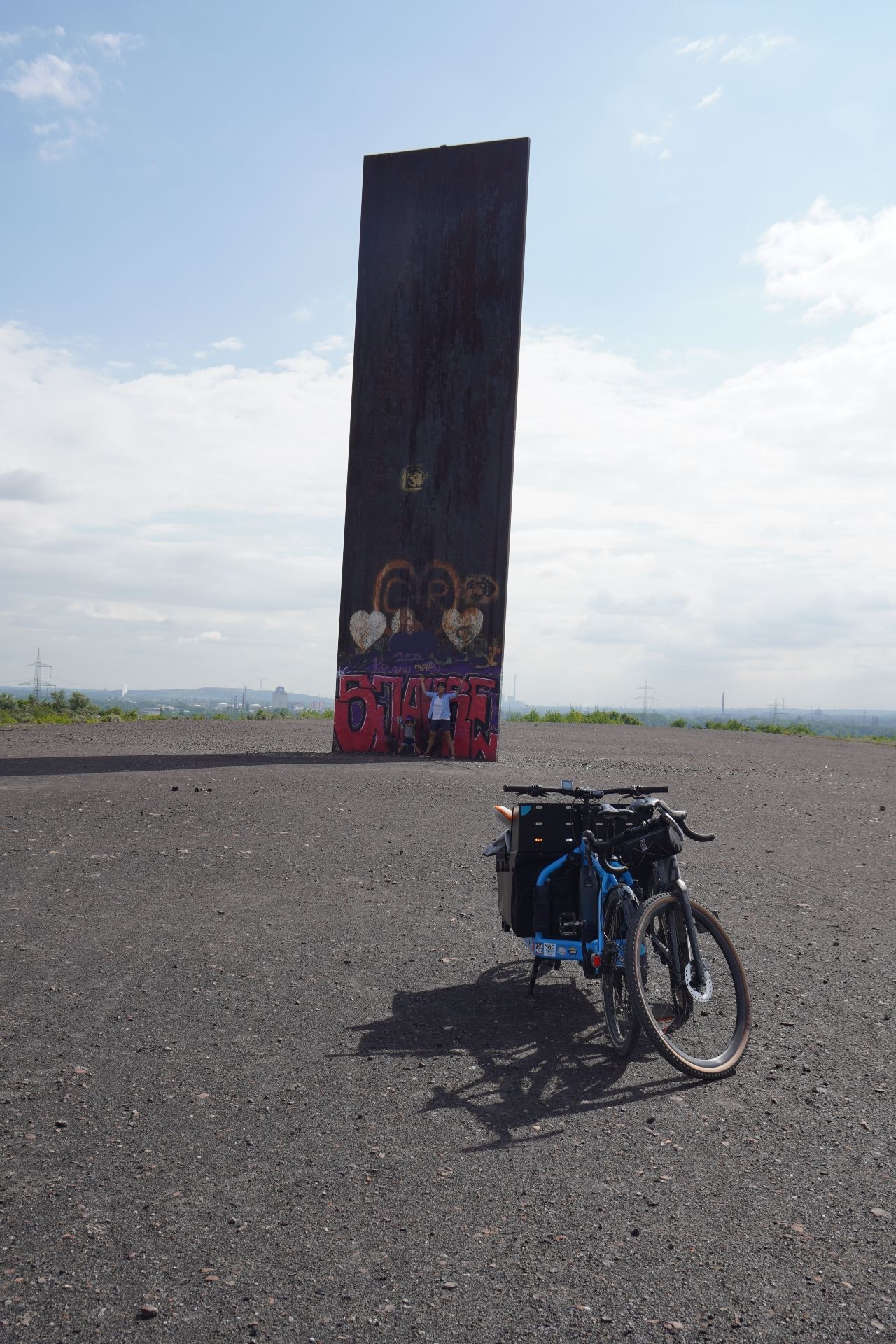
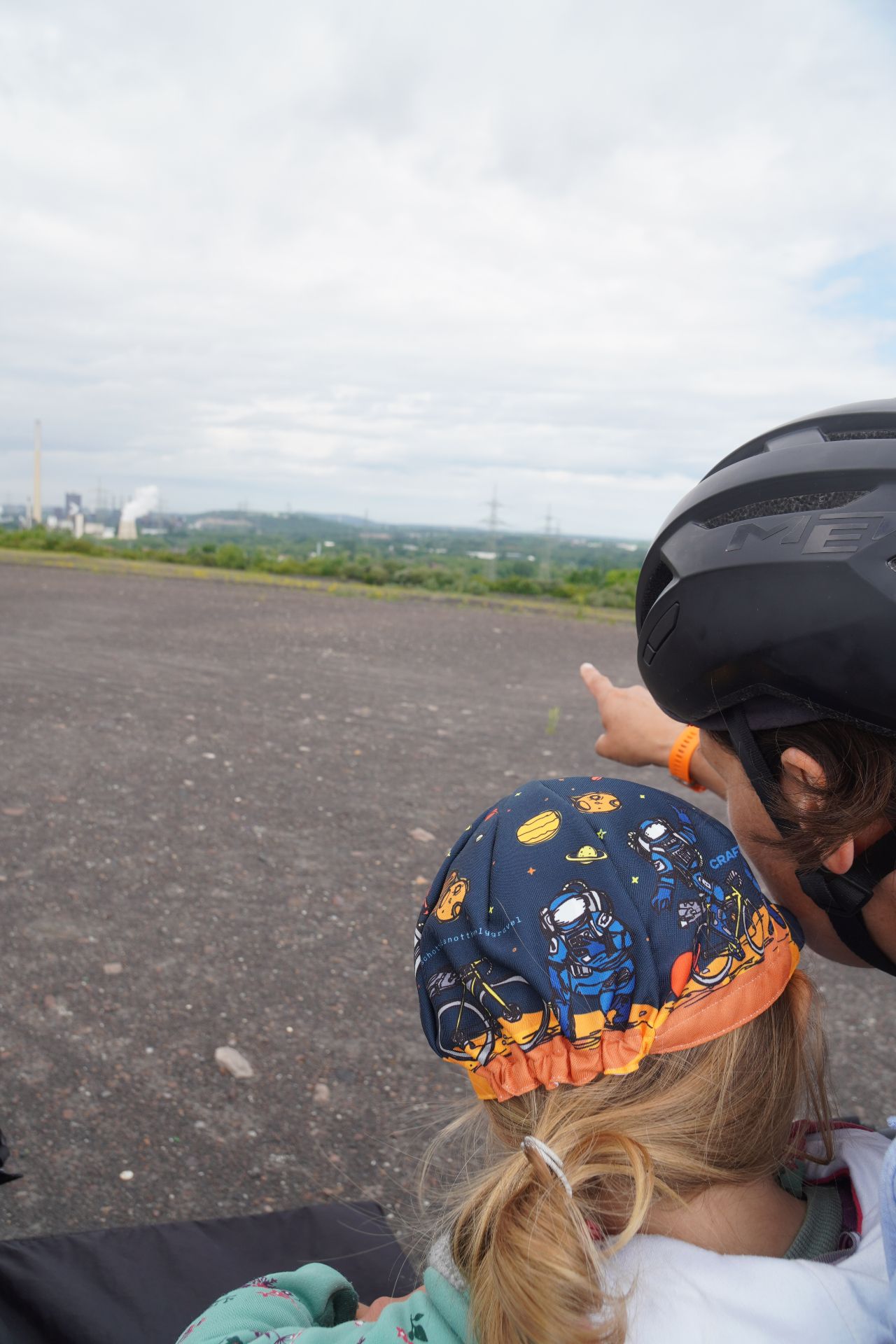

After crossing the Rhine-Herne Canal, we made our way through one of the typical colliery housing estates and finally found ourselves in Bottrop. The little houses were more reminiscent of dreamy fairy tales than the rubble and ashes of a coal-dusted labour region. We took a run-up and conquered the "Beckstraße spoil tip", better known as the "Tetraeder spoil tip". At 73 metres, it is one of the highest of the surrounding peaks and its 60-metre high climbing frame is even more impressive. Bente went wild and asked us to dance on the tetrahedron.
Back on the Haldentop, we munched on our delicious "Bütterken" and admired a gigantic, bright white cloud of fire on its way into the sky. Bottrop is still home to one of the few operating coking plants in the country, as we were to learn the following day.
On the horizon, the gasometer accompanied us again and again in its rapidly growing appearance. We approached Oberhausen with a few playground detours and thus ensured Bente's good mood. It wasn't difficult for us to notice a number of works of art along the way just by driving past. These included, for example, the dancing electricity pylon called the "Sorcerer's Apprentice", which I had previously only recognised from photos. However, the reality was much more impressive. The many tonnes of steel used in the collected industrial monuments and buildings reminded us that steel also played a very important role in our region.
Jule Wagner, View of the Tetraeder on the Halde Beckstraße in Bottrop Jule Wagner, Cyclists ride on the Halde Beckstraße in Bottrop Jule Wagner, A woman and a child descend the stairs of the Tetraeder at the Halde Beckstraße in Bottrop together Jule Wagner, The Zauberlehrling, also known as the Dancing Electricity Pylon, is located in Oberhausen
Sustainability in a nutshell
"How huge this gasometer tin can is," I stood in front of the giant cylinder in amazement once again, while Sabine and Bente already had the lift door on the outside firmly in view. Their true extent was revealed when we visited the roof. Because up there, at 117.5 metres, we reached the highest vantage point of the weekend, the most distant view and my knees were in a liquid state. I bravely ventured onto one of the viewing decks and shared the thunderous applause with the pop artists at the music festival in the immediate neighbourhood.
I was pretty happy when we were back on the ground and in the cool interior of the old gas holder. Bente was a little less so, because the exhibition "The Fragile Paradise" was followed by a bit of an adult programme for us, but one that was also of particular interest to our children. The moving climate story of our planet aroused emotions that are difficult to express in words when you feel deeply connected to our planet like we do. You can still visit this moving exhibition until the end of 2022. I would almost like to ask for it.
With lasting motivation in the truest sense of the word, we set off on the first few metres of the way home. Whilst Bente was still processing the adventures of the first half of the tour in her sleep, we treated ourselves to a short and relaxing visit to the beer garden with a break for the children. "The route knows what parents need," we laughed together as we sipped a cool beer in the fresh, sunny air.
The rest of the route took us through the predominantly wooded Hexbachtal valley on shady, refreshing paths and led us directly to the "Radschnellweg Ruhr" cycle highway. The RS1 will one day connect the cities of Duisburg and Hamm, and with it many delicious rest stops. Of course, some of these already characterised the section that still lay ahead of us. And as if Bente had timed her nap for the "scoop of chocolate in a cup", she opened her eyes again just before the "Radmosphäre". The Radcafé offers great conditions for feeling good and meeting cyclists. If you're not enjoying an ice cream in the sun on the Niederfeldsee lakeside promenade, you'll also discover chainring lights, rim tables and headlight-style sparklers at the heart of the premises.
But before the lights on our bikes were put to use, we cranked our way back to the actual starting point of the circular route. With dinner in "The Mine" restaurant in the southern winding engine house of the Zollverein colliery, we got into the mood for the following day in the midst of the industrial backdrop between the winding tower and Bente's girlfriend, the giant escalator. This was to be dedicated entirely to the impressive site and add a little more depth to our limited knowledge of the cultural history of coal. There was only one more night between us and the steep learning curve. And with it the last of the short trip.



Coal and its legacy
The morning began with packing our few things. To be on the safe side, Bente had made sure that we had packed everything away before breakfast. So after eating together, I found myself back at reception to check out. The last excursion got off to a quick start.
The light luggage waited patiently at the hotel while we set off again on wheels towards the Zollverein. The tailwind initially pushed us on our own across the extensive grounds of the colliery and coking plant. At almost every corner we found artistic structures, huge machines and, of course, plenty of climbing and jumping opportunities for our daughter's fully charged battery.
Our childlike curiosity gladdened our hearts, but also melted our ample time window. We soon found our way back to the coking plant information point via an avenue of chimneys. A small crowd of inquisitive people had already gathered here. We were to learn about "coal, coke and hard work" in a 2-hour guided tour and literally gain deep insights into the production processes of what was once Europe's largest central coking plant. Embedded in the history of the entire colliery circus, we followed the traces of the coal to the coke - which, by the way, was cooled down with a huge amount of water after it fell out of the oven and sent a cloud into the sky. An extinguishing cloud.
We climbed up the disused service roads, entered cosy coal chutes, peered into huge, jet-black coal bins and regularly answered Bente's question as to why we had to stop again, to the joyful laughter of the group.
The authentic atmosphere brought the mood of the disused plant to life. It was always particularly impressive in the interior areas, as the dusty smell of coal was still in the air. Despite exciting video reports from former employees, lively explanations from our group leader and our daughter's deep black bath water from later in the day, we could only guess how hard and under what conditions people worked here. Around the clock. 365 days a year. Insane. These colliery days.
We ended our journey through the bygone era of coal culture with a bag of chips in the "Bistro Schacht XII", which of course should never be missing on a real pot weekend. In the shadow of probably the most famous winding tower in the world, we summarised the past three days in a worthy setting. Wait a minute. Three? And the only way we could tell that it wasn't at least a whole week was by counting. Micro adventures. My arse.
Jule Wagner, The Zollverein World Heritage Site in Essen is a suitable meeting place Jule Wagner, Mother and child jumping on rocks at the Zollverein World Heritage Site in Essen Jule Wagner, View of the Zollverein World Heritage Site in Essen Jule Wagner, The family takes a break to recharge their batteries at the Zollverein World Heritage Site in Essen
The macro in the micro
The fact that we had found so much that was unfamiliar in the familiar left us astonished. Especially me, who somewhat arrogantly believed that I knew the Ruhrpott in all its facets and was now able to introduce her new wife to the enchanting contrasts. The fact that we would rediscover the wetlands of the coal industry landscape together that weekend was completely beyond my imagination. The contrast between the industry that has shaped our country so much and the vigilant nature that patiently bears our history is always remarkable. "I really don't know of any place where the two have interwoven so impressively as up here, in the entire northern part of the Ruhr metropolis." And Sabine agreed with me.
The Ruhr region has not only shown us how valuable, important and beautiful our home is, but also that holidays are what we make of them. That we have everything we need for it. Because holidays are just like home: a good and great feeling in your heart.
Jule Wagner lives and cycles with her wife and young daughter in Essen and works as a freelance illustrator and graphic designer. Jule communicates her fascination with cycling through her illustrations and texts on her blog and social media channels.
